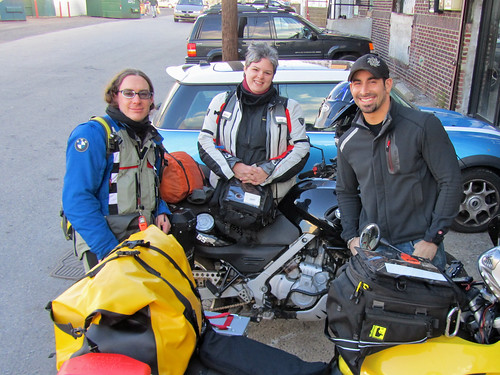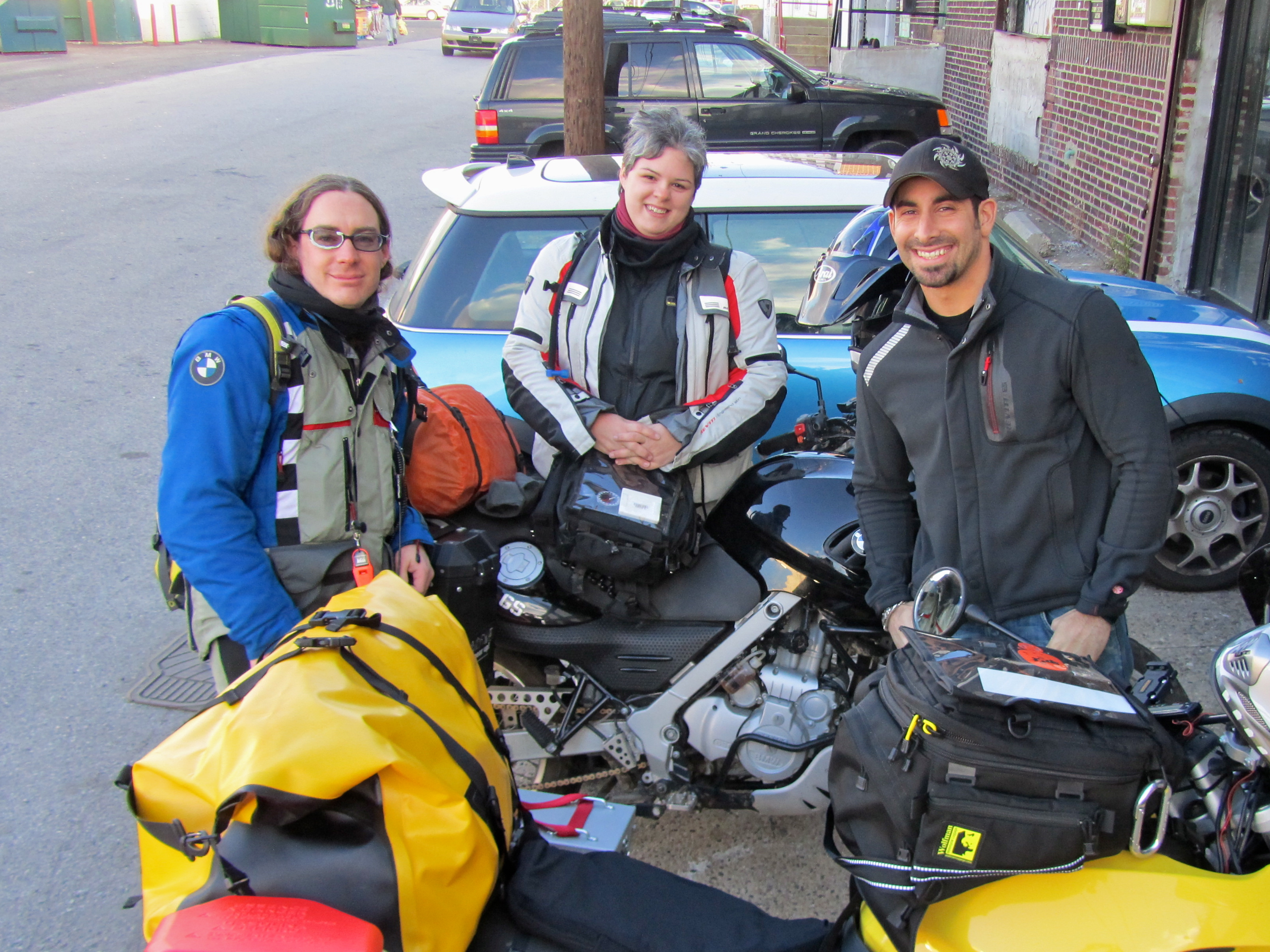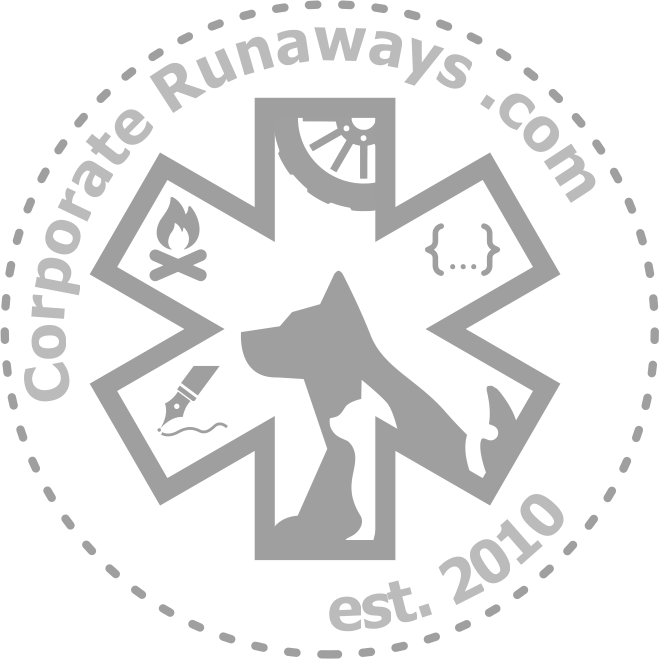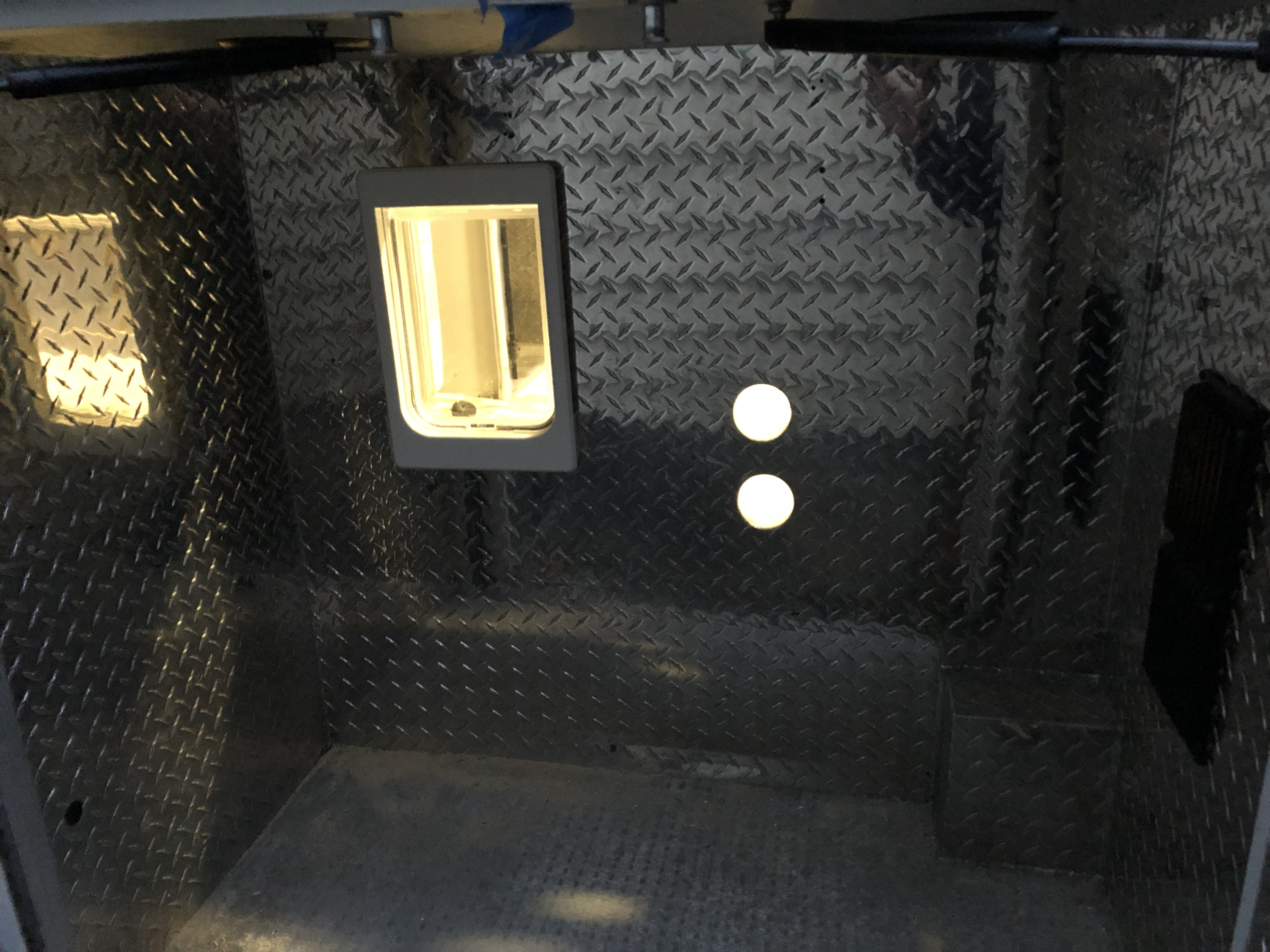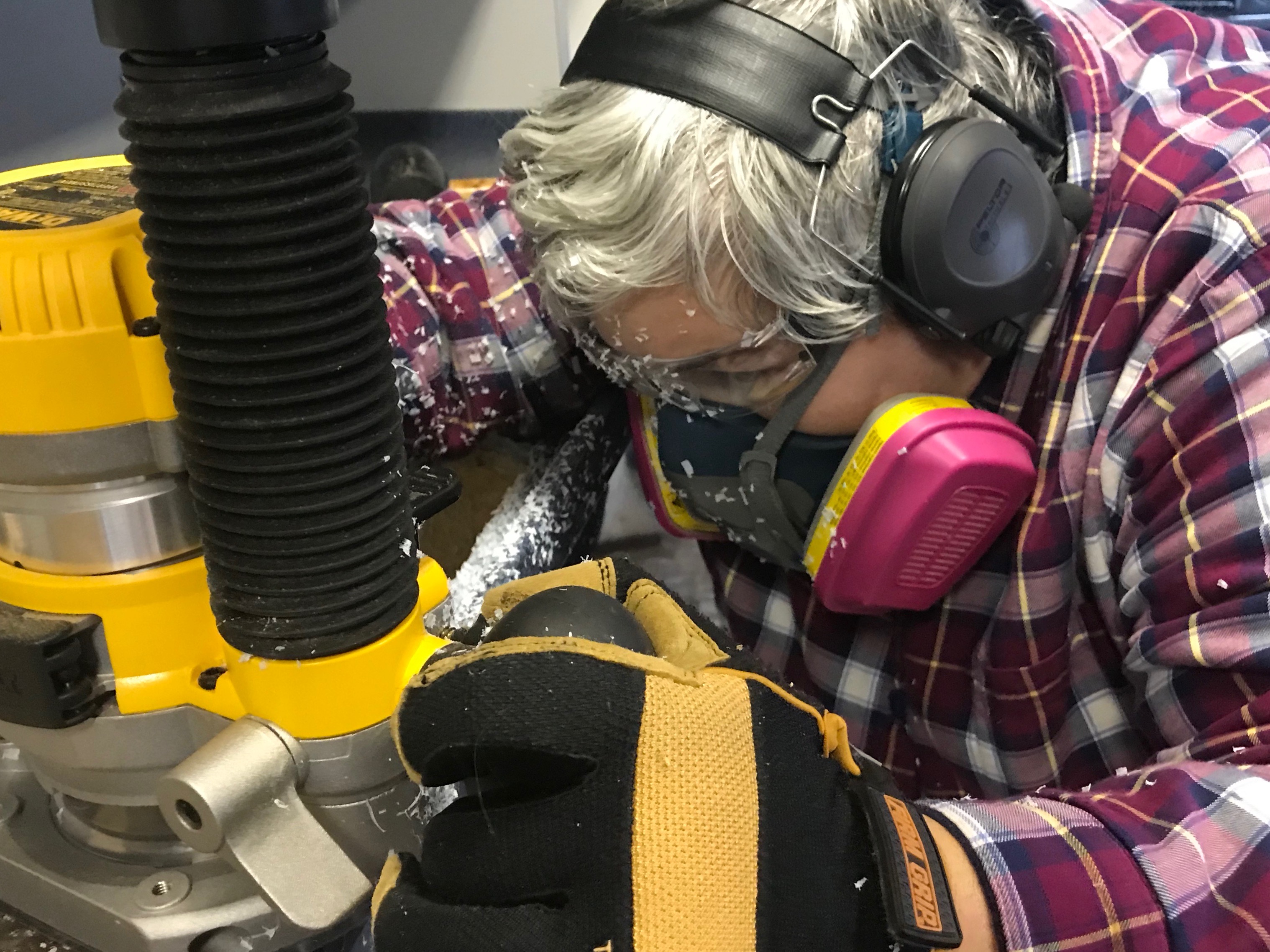Most of the items we brought with us worked as expected. Some were outstanding and require special mention. Some items seriously disappointed us. Some items simply deserve some comments to help you when considering items for your next trip.
Outstanding items:
The Wolfman Rainier tank bag
Normally we don’t think much about tank bags. You get the size you want and they either work, or they don’t, and they’re not worth much mention, but throughout the trip we kept commenting about how much we loved these. Excellent build quality, and so much expandability that when we encountered another rider with one fully expanded we didn’t recognize it. The expandability was great, as it made it easy to stow things in the tank bag for a short time. Have some soda left from lunch? No problem, just stick it in your tank bag. Grab some cookies or a bag of chips to snack on later? Tank bag can hold it - just expand the zipper. At one point, Kay had octane booster and a quart of oil in the tank bag in addition to all the normal stuff he stored in there (big, expensive camera, Spanish-English dictionary, stickers, helmet cleaning stuff, toilet paper, etc.) and it still had more room.
The map pouch is great, as it doesn’t leave your map soaking wet after a rain. And as a nice added feature, you can get backpack straps for the tank bag so that when you step off the bike to spend a couple hours touring a ruin, you don’t have to worry about people walking off with your tank bag or their contents. We also bought one set of the larger outer pockets and put one side pocket on each bag. The larger front pocket made storing the rain cover (which is very well designed, highly effective, and can have the map pouch stuck on it ) and the backpack straps slightly easier.
As much as we love the Rainier it should be noted that we had one problem with it. There’s a strap across the front edge of the bag that you grab and carry it by when you walk away from the bike. Kay’s came undone on one side and Dachary’s webbing is starting to fray at the same place. Fortunately, there is a plastic D-ring next to each end of the strap so Kay simply cut off the strap where it was still attached and tied a piece of spare webbing (always carry spare webbing) to each of the D-Rings. Instant replacement strap.
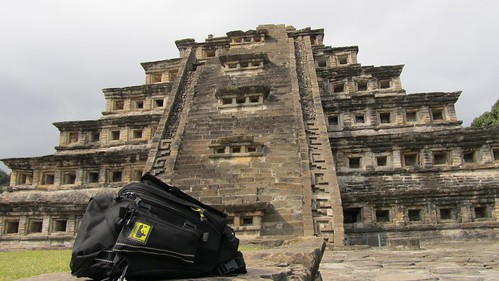
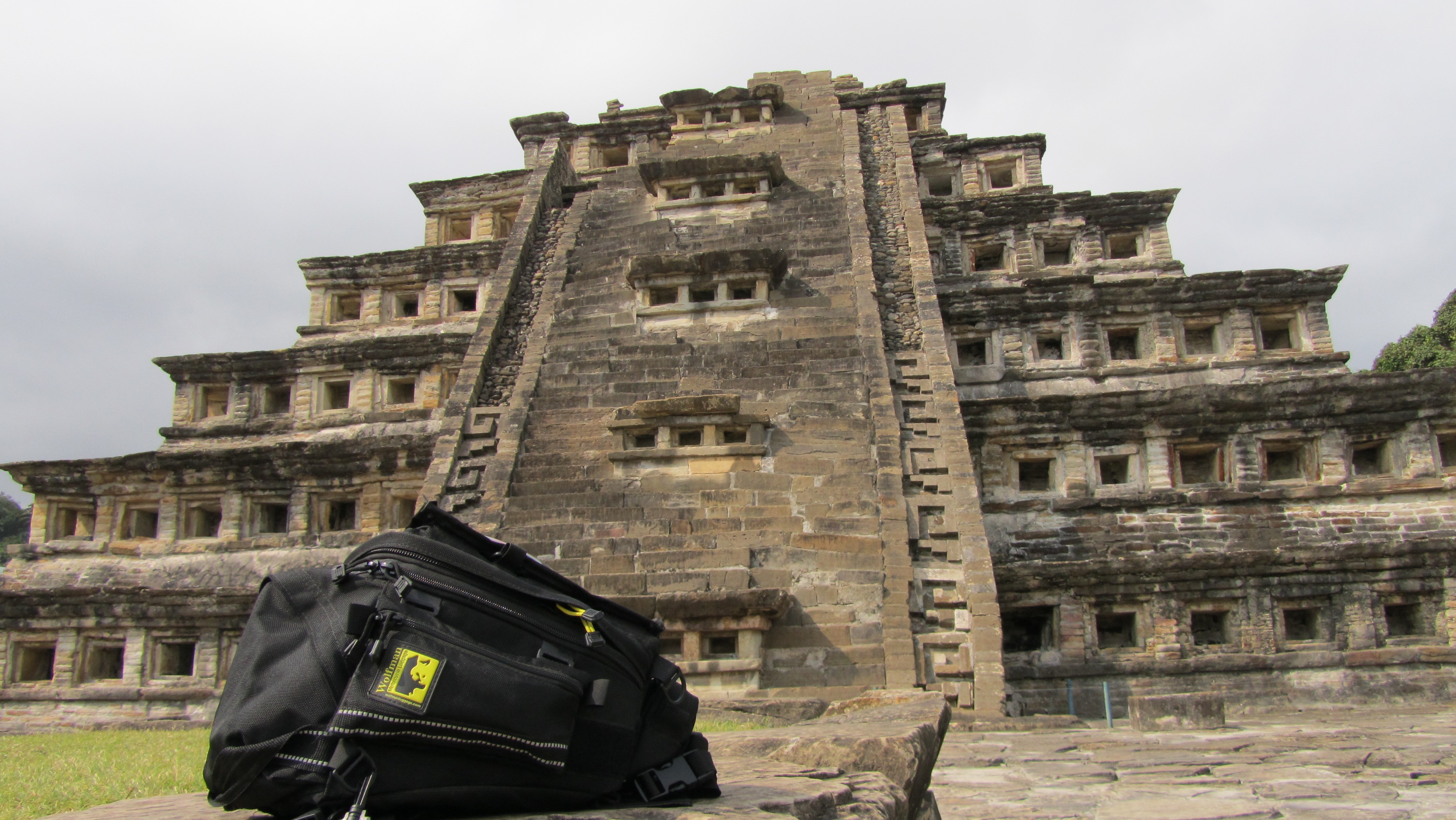
The BeadBreakr and CyclePump from Best Rest Products
The F650GS has a notoriously difficult bead to break and, with one exception, the BeadBreakr made that trivial. While a number of people just take regular electric pumps for cars and remove the plastic housing we really appreciated the compact and hard-to-kill housing of the CyclePump. Plus, it has an SAE plug on the end (as well as a bunch of adapters) so we didn’t have to attach an SAE to Cigarette adapter to use it. Also, it easily pumped in enough air to set the bead for us (they’ve got another tool for setting the bead on non-tube tires).
We also brought a manual hand-pump we could use for minor top-ups, and in case this one went out on us, but we never had any problems with this one and ended up never using the manual hand pump. We’re lazy and this electric pump was highly effective, fast and easy to use.


The Leatherman Wave
A multi-tool is a must-have on any trip like this, but you can by an incredibly compact set of bits for this one that give you hex (metric and US), torx, phillips, and flathead ends. We used this constantly.
Dries fast, lives up to all its claims. Would absolutely buy again. Is stink-resistant and very comfortable to wear under motorcycle clothes (Dachary says more comfortable than regular cotton underwear).
Smartwool T-shirts (or any other merino wool t-shirts).
They wick well. They dry very fast. You can sweat in them for days and they still won’t be stinky once they dry. Thin enough that when the wind hits a sweaty shirt through your vents you get all the cooling benefits that sweating is supposed to provide you with. The 100% cotton t-shirts we brought with us got nasty after one day of sweating in 100 degree F (38 C) weather and took too long to dry if the night was cool. So we’d be carrying around wet cotton shirts for days, or wouldn’t bother washing them because they’d take too long to dry. Smartwool or other merino wool totally negates this issue.
Merino wool socks.
We used thin “liner socks” on hot days and thick Smartwool winter ones in the cold. Don’t believe the claims about being able to throw them in the dryer, but everything else it true. They resist stinking ( although they can only do so much against feet ) and the thick ones keep you quite warm. They dry fast, too.
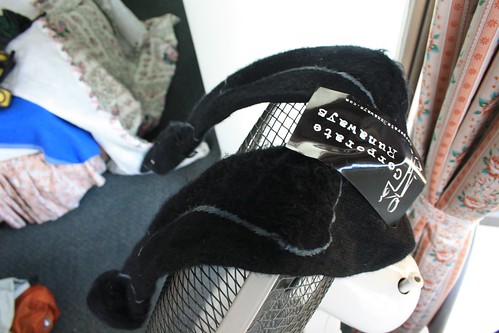
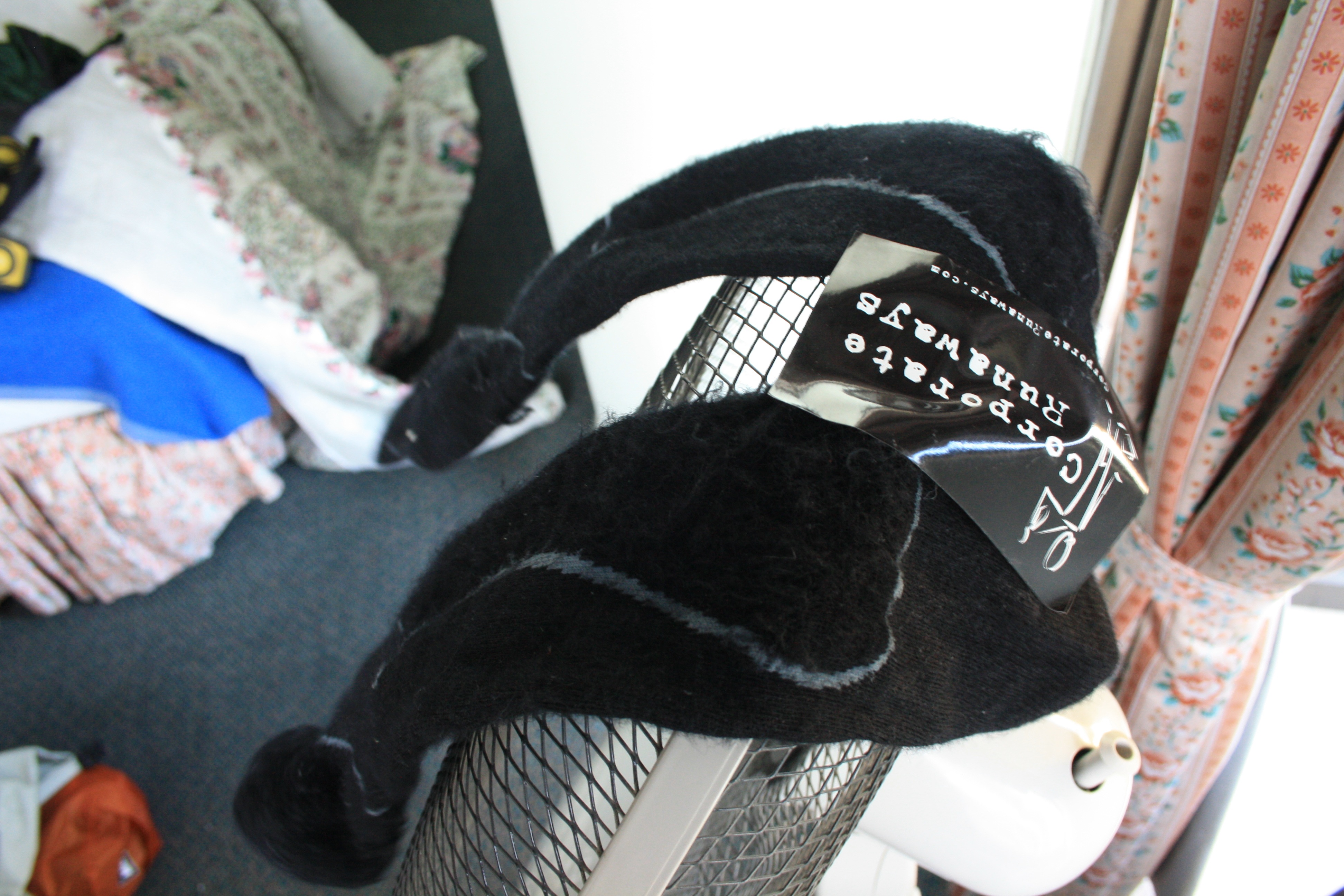
Vinyl stickers
No, seriously. We fixed and bodged so many things with these stickers. Bag of pasta came open? Sticker. Socks won’t stay on the fan to dry? Stickers. Hole in the toothpaste tube? Stickers. Pannier corner falling off? Lots of stickers. Identifying luggage at the airport? Stickers. Yeah yeah, We hear you yelling about your duct-tape. We have that too, but we liked the stickers, and they don’t leave a residue when you remove them like duct-tape does. Also, we love getting stickers from other riders and leaving ours in interesting places. You should totally get some made for your trip.
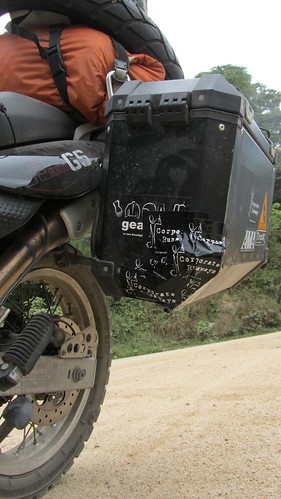
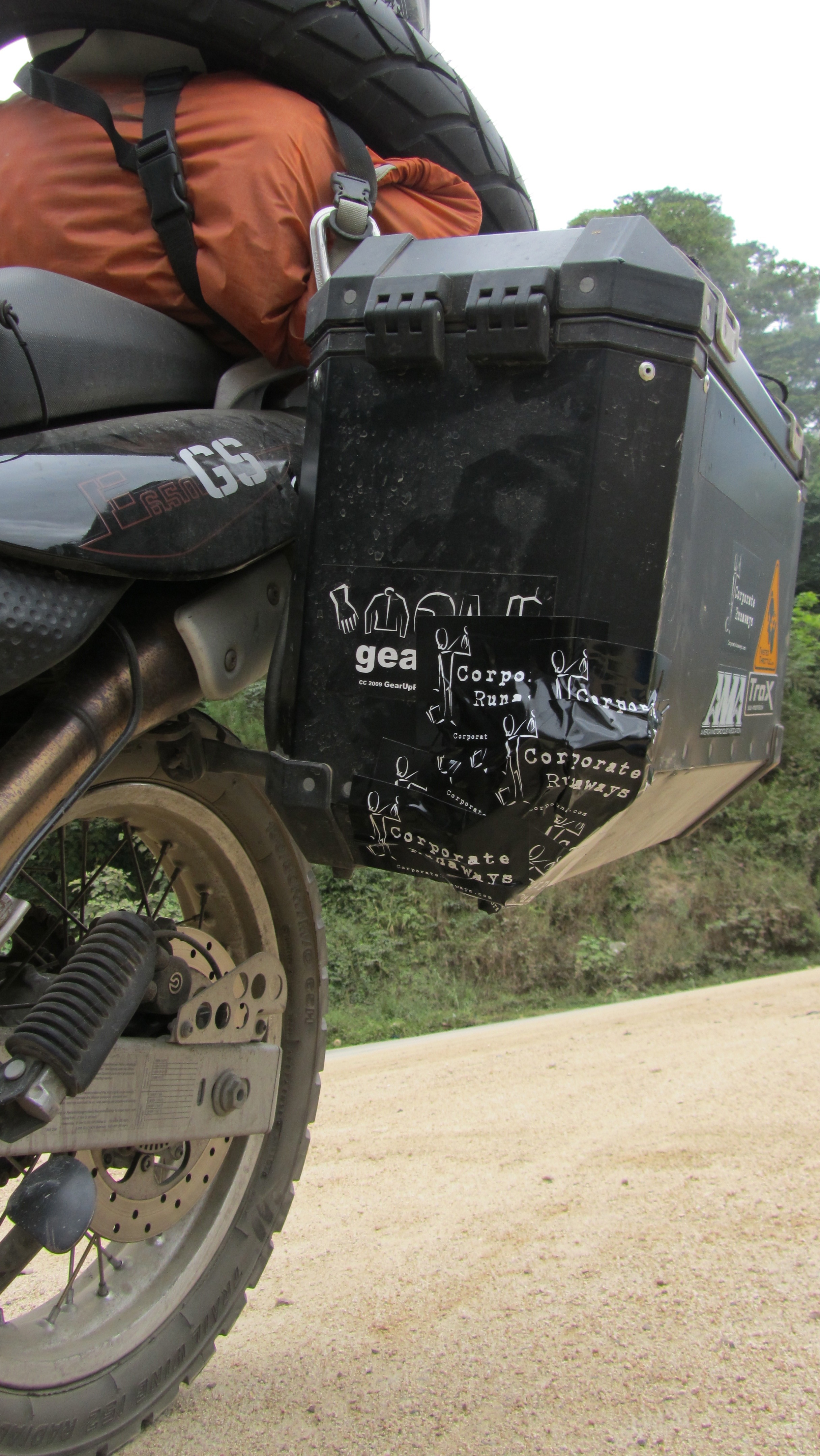
Cyclone Buff
A buff is essentially a stretchy cloth tube. The cyclone buff doubles the stretchy layer for warmth and then attaches a thick piece of Goretex Windstopper fleece. Which is warm and absolutely kills the wind. Wear it as a neck warmer. Wear it as a balaclava. Wear it as a hat. Many of our days would have been painfully cold on the neck without something like this, and without a cyclone buff you’re pretty much relegated to wrapping large scarves around your neck or using a balaclava which is not only single use, but also doesn’t go as low under / over the neck of your jacket. We brought normal, lightweight, buffs too and used them to keep bugs from pinging off of our necks, or to keep Kay’s long hair in check before the Honduran barber got ahold of it.
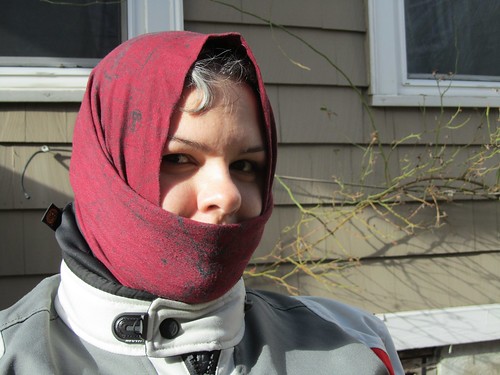

We were thrilled with these gloves and can’t recommend them highly enough. We rode at highway speeds in sub-freezing temperatures and they kept our hands as warm as any other non-electric gloves would. The real problem was keeping our core temperature up. We rode in cold high-altitude climates with pouring rains and hail and putting these on was almost a delicacy. Our hands never got wet with them.
The only note is that they are absolutely designed to work in conjunction with heated grips. The leather on the palm is standard summer-weight which makes them more comfortable and easier to close your hand and grip the grips, but would be a bad choice without heated grips. As a result, they provide good tactile feedback on the controls but they’re not as warm as some of the massive snowboarding-style gloves. Perfect with heated grips, but not warm enough without. Also, in sub-freezing temps even with heated grips, our fingers got cold on some days. For regular commuting in sub-freezing, would probably get heated gloves. For this trip, though, they were the perfect choice.
Kindle software
We wish we had Kindles (see below) but, lacking them, the Kindle software on our iPhone and iPad enabled us to relax with good books in the evenings; something that was very much appreciated. Dachary read 21 books on the trip, and there would simply have been no room to carry around that much paper. Reading on the phone wasn’t ideal (hence the wish we’d brought Kindles) but it made reading possible when it wouldn’t have been practical otherwise.
Items we wish we’d have brought:
We got sick of our GoreTex and Hydratex rain liners leaving us damp. We really disliked walking into restaurants with shells that were soaking wet and left puddles below our chairs, even worse in a hotel. Putting them in on the road was so annoying that if it wasn’t cold we’d simply skip bothering with the leg ones. Frogg Toggs have an excellent reputation amongst riders, hold up to highway speed winds, and don’t feel like cheap vinyl. We’ve also heard that they help as windbreakers, and while our layers are *supposed* to do that, they weren’t all that effective. There were times on the trip that an extra wind-breaking layer would have made a huge difference in warmth and comfort.
Better external dry sacks.
We bought an outdoor research dry-sack for the tent, Dachary’s sleeping mat and something else. It seemed good when we bought it but it wasn’t designed to survive the stresses of living on the back of a bike for four months. Next time we’ve decided that any dry-sack that lives on the bike will have to be heavy-duty PVC material like the bags made by Ortlieb and Wolfman. The Wolfman Expedition Dry Duffel on Kay’s bike has been beaten, dropped, dragged, and shoved. Kay let one of the clips dangle against a muffler, melted off half of it, and it still held tight when he put it back. The extra d-rings were great for attaching bungies, or whatever, and the only negative comment we have about it is that the handles that meet across the top aren’t quite long enough to meet when it’s full. We’d absolutely buy another one but can’t decide if we want one that opens along the top or on the ends next time.
Another bra
Dachary brought two bras but wished for a third because they take a long time to dry and they get skanky when you wear them. The non-sports bra was more comfortable but the sport-bra dried faster.
Sewing supplies
There are things we’d have fixed if we’d have brought a needle and thread.
Cardo Scala Rider G4 headsets
We bought these in Mexico City when the Senas died. We chose ease of use over known reliability in the beginning. The Cardo’s aren’t as easy to manipulate, and when it rained one of us would generally be unable to speak to the other, but the hardware design is hard to damage, and they’ve got a history of reliability.
Kindles
If you like to read there’s no getting around the fact that you can’t carry enough physical books and you’ll have trouble buying more along the way because they’re mostly in foreign languages. The kindle’s e-ink screen is very easy on the eyes, it’s small, lightweight, has a literal one month battery life, and can hold tons of books and download more whenever you get a net connection. We used the Kindle software on Dachary’s iPhone (better screen) and Kay’s iPad (bigger screen) but really wished we’d had actual Kindle’s. Next time we will. Reading almost exclusively in the evenings and a smidge in the mornings Dachary devoured 21 books and Kay went through 12. There’s no way we’d have been able to carry that many paperbacks. It should be noted that Kindle books almost always come with Digital Rights Management (DRM) which means they could literally become unusable at any moment, but right now there’s no better way for an adventure rider to read on the road.
More Lithium Batteries
Spot Trackers require lithium batteries for a variety of reasons. You will have an incredibly hard time buying them outside of your home country. So stock up before you leave. We think we got approximately three weeks of constant tracking (while riding) per set.
A small container of grease
The grease on Dachary’s rear axel seemed to wear away. The last time we changed her tire we were seriously concerned about how little there was. The gas station didn’t have any but a local mechanic, when asked for grease, squirted some oil on the axel… “Well,” kay thought, “it *is* a lubricant”.
Tiger Balm
Tiger Balm is one of those creams that feels hot when rubbed into sore muscles. In addition to being very effective it also happens to come in a very small bottle (you don’t need much).
Tea and Coffee
Kay’s always been a tea fan and we were constantly being offered tea or coffee with our breakfasts. The problem is that other countries have different ideas about what constitutes a decent “black” tea. For a while Kay kept getting black tea with cinnamon and cloves. Bleh. He regretted not having brought along some “good” tea.
Dachary wasn’t a huge coffee drinker before the trip, but did appreciate “good” coffee. Kay got her a insulated mug / french press to be her one luxury item on the trip, but she decided against it to save space. It was a decision she’d come to regret after being frequently served bad instant coffe and discovering that “cafe con leche” was really “leche con un poco cafe”.
About three months into the trip Kay developed an uncomfortable case of Trigger Finger as a result of constantly gripping the throttle. He actually left one at home because he disliked how it felt in the way on the grip and had no problems on his previous three week trip riding around the states. While we don’t like the idea of motorcycle cruise controls for safety reasons we recommend bringing a Throttle Rocker or something similar. If nothing else, throw it in your pannier just in case.
Items we regret choosing:
Sena SMH-10
Our trials and tribulations with this have been thoroughly documented. We can’t recommend buying these. Go with one of the Cardo Scala Rider models.
Synthetic sleeping bags
They don’t pack small enough and we wished we’d have invested in ones with a lower temperature rating. We’ve since been told that down packs smaller and is generally good to lower temperatures. For the next trip, we’re looking into down sleeping bags that can zip together so we can share body warmth on really cold nights.
Normal sneakers
Kay brought some good sneakers designed for running off-road. They resist squishing and take up way too much space. Next time he’ll bring converse low-tops because they squish very flat and you’re not off the bike enough for good tread to be a real concern. Dachary’s Ahnu Reyes Sandals squished well and had good tread, but occasionally got rocks or sand in them. She’d “absolutely” bring them again. Kay ended up using Dachary’s sandals frequently when she wasn’t using them herself because they were easier to deal with than Kay’s shoes (i.e. didn’t require socks, and Dachary always had them with her).
5 Function Digital Meter from Aerostitch
A great idea but a horrible execution. The device was never designed to be exposed to the elements. Aerostitch claims it’s “not extreme weatherproof without custom modification (disassemble, apply silicone sealant, reassemble)”. We claim it isn’t weatherproof at all without that and that a motorcycle company shouldn’t be selling a device that isn’t capable of being used on a motorcycle without such modifications. We do know of one rider who’s done the custom sealing and had no problems.
Aerostitch Triple Digit Rain Covers
Simply not worth the effort, slippery, and when incorrectly worn fill up like water balloons.
Touratech sidestand feet.
Both had the bottom layer bend down either slightly or severely, and then fell off.
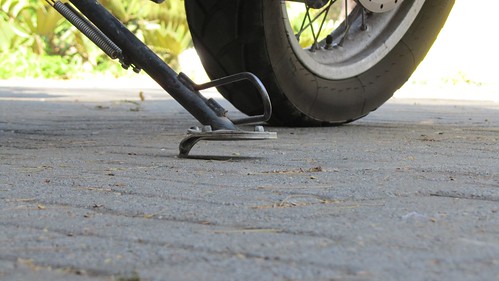
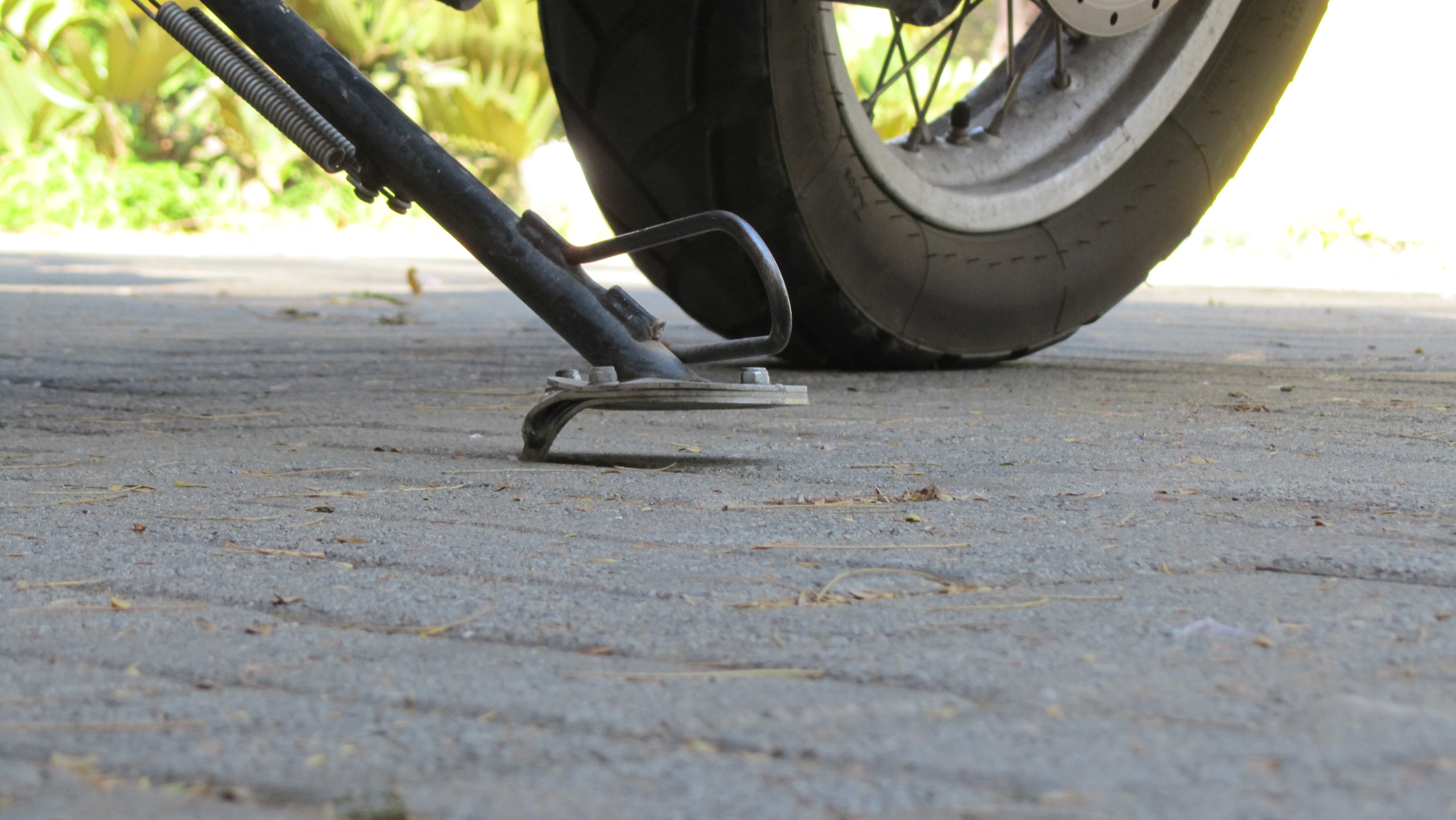
Bike things that broke:
Kay’s ABS, or rather, the ability to turn it off.
The 5 function meters.
Three inner tubes (rear flats on Dachary’s bike).
2 SW-Motech Quick-locks (hold the pannier frames on).
Corner of SW-motech Trax pannier.
Watertightness of SW-Motech Trax pannier.
Key to Trax pannier broke off in lock.
AirHawk straps (3 out of 4 ripped off).
BeadRider began unraveling
Engine Gasket on Dachary’s bike.
Dachary’s bike has gotten a few inches shorter in the rear.
Tail light / license plate assembly for Kay’s bike.
Fork Seals on Kay’s bike.
Gas light on Kay’s bike.
Neutral light on Kay’s bike.
Cooling fan on Kay’s bike.
Important bolt fell out of Happy-Trails rack on Kay’s bike.
Oil leak on Kay’s bike.
Metal loop on Kay’s kickstand.
Low beam on Kay’s bike.
Odometer / trip meter on Kay’s bike (stuck on trip meter at 0.0)
Rear left blinker on Kay’s bike (dangling by wires)
2 Touratech sidestand feet. - Both had the bottom layer bend down either slightly or severely, and then fell off.
2 Mirror stalk screws that hold the mirrors on (designed to break easily).
Laminar Lip / Wind deflector at the top of Dachary’s windshield.
A few of the array of screws that provide traction on the Fastway Pegs fell out of 2 pegs despite having used red locktite.
Dachary’s Touratech chain guard broke where they always break and Kay’s has a crack most of the way across.
Other things that broke:
Dachary’s Gerbing jacket.
Dachary’s second garbing jacket works but shocks her.
Dachary’s RevIt Rival H20 boots (zipper wouldn’t zip, then came off).
Some stitching in RevIt Sand pants and jacket.
Kay’s glasses (stepped on).
Sena SMH-10 Headsets.
Lid on our pot melted (user error).
Waterproofing on Dachary’s replacement boots.
Waterproofnees of Hydratex in Dachary’s Rev’It Sand Jacket and pants (she gets wet, not damp).
Cheap dry sacks getting holes.
Contour GPS camera (usb port fell inwards).
Cord pull tabs on three zippers on the BMW Rally Pro 2 suit fell off (zipper is unaffected).
Camelbak bite valves. (Kay’s popped off repeatedly. Both now leak, Dachary’s since Nicaragua )
Camelbak lock thing that keeps water from coming out at all (Kay’s fell out twice spewing water everywhere).
Metal underwire in one of Dachary’s bras broke and had to be removed.
Shutter on one point and shoot now fails to always open completely (repeatedly dropped)
Lanyard keeping point and shoot from flying off the bike broke and had to be tied.
Both point and shoots now have scratches on the lenses (only one was used while riding).
One spork.
Injuries and Ailments:
Kay’s back was thrown out twice (lift with your legs not your back).
Far too much diarrhea (twice badly enough to keep Dachary off the bike).
Dachary’s left shoulder in a fall.
Dachary’s left shoulder/neck when reaching for a fan cord.
Kay’s ankle - bruised the bone when trapped between pannier and sand. Hurt when pannier fell on it a second time.
Kay’s shoulder (can’t remember which or why)
Somewhat serious case of trigger finger in Kay’s right hand.
Dachary’s knee and ankle got scraped from falling whilst walking on sidewalk.
Dachary’s hand got scraped on pannier and then on hanger used to hold stuff in pannier lid.
Dachary received a second degree sunburn as a result of standing for too long in the Colombian sun without sunscreen.
Dachary experienced severe Altitude Sickness in Bolivia ( shortness of breath, migraine, coughing, dizziness).
Assorted minor bruises and muscle strains.
Dehydration headaches.
Camping:
We didn’t camp nearly as much as we’d planned but we still used pretty much everything.
REI QuarterDome T3 three man tent
This worked exceptionally well and we’d highly recommend it or the two man version (the T2).
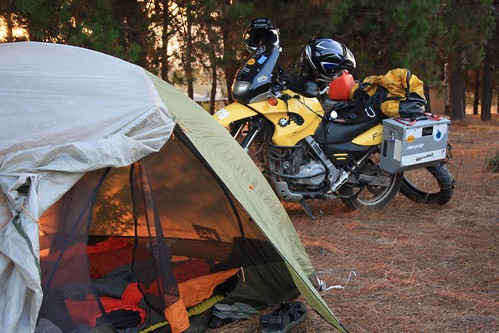
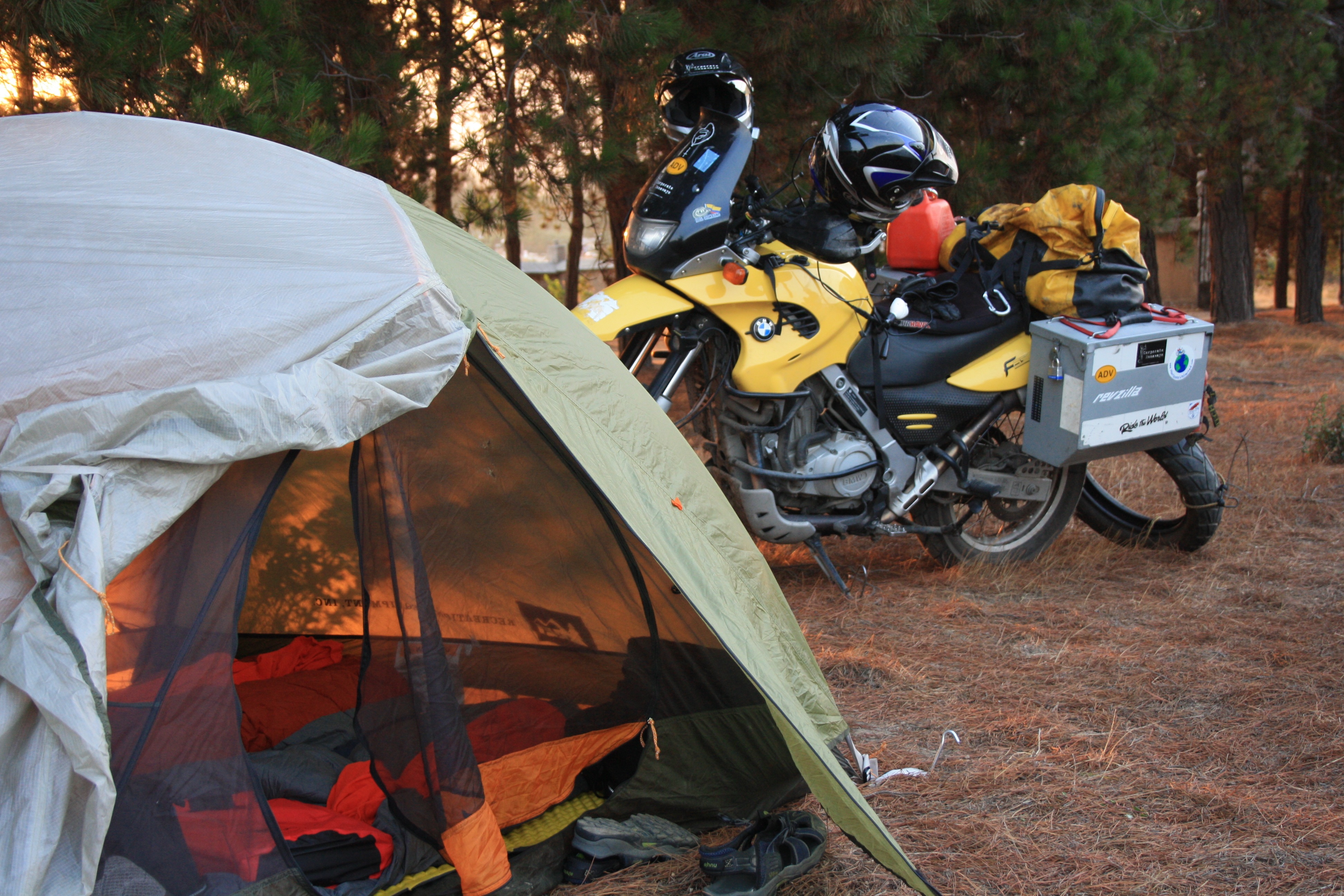
Sleeping Bags
Our sleeping bag choices were poor. Kay’s only experience with down is an old World War II sleeping bag he has that is effing warm but doesn’t compress very well. Along the way we learned from other riders that good down compresses exceptionally well. So we’d go for down sleeping bags next time. Also, if you’re traveling with someone else be sure to get sleeping bags that can zip together should the night prove unexpectedly cold. Next time we’ll bring bags that are rated down to at least 20 deg F (-10 C). Remember that the temperature ratings on sleeping bags are not standardized and generally indicate the lowest temperature it will keep you alive at, not the lowest temperature you’ll be comfortable at.
We did bring sleeping bag liners, which were supposed to give us an extra 25 deg F of temperature range (see below).

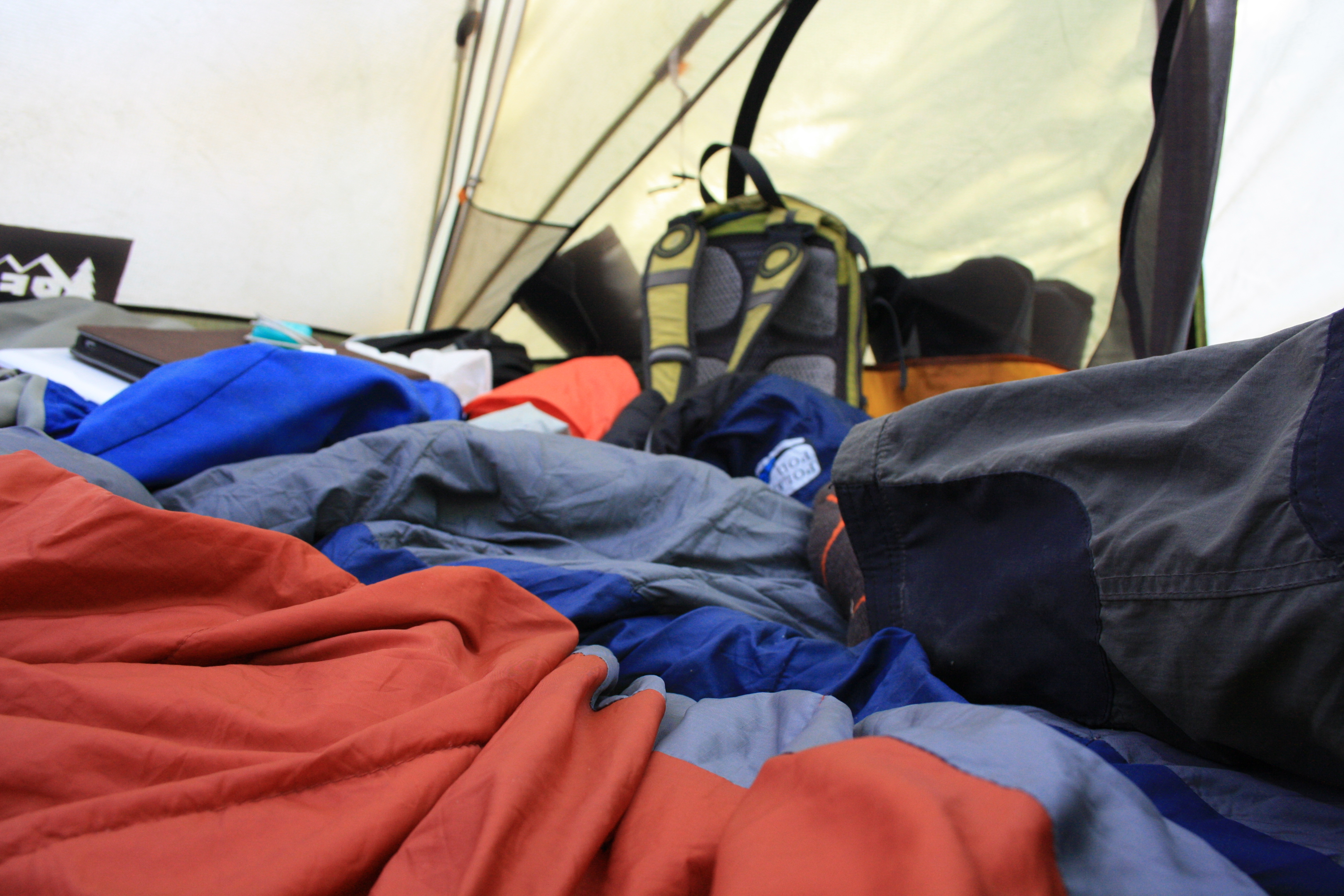
Sleeping Bag Liners
We both brought the Sea to Summit Thermolite Reactor Extreme Mummy Bag Liner which claims to add up to 25 degrees F of warmth. We’re not convinced of that claim but it did help keep us warmer, is far easier to clean than a sleeping bag, so if you get sweaty, just wash the liner - don’t worry about cleaning the bag. Also, your skin doesn’t stick to it like it does to sleeping bag material. On hot nights we’ve put the sleeping bags under us for padding and just slept in these. We’d definitely recommend these. For storage we ended up just leaving them inside the sleeping bag which we shoved in a compression sack.
Therm-a-Rest Z-light Sleeping pad
We bought this because it folds up into a square shape instead of the standard foam sleeping pads which roll up into a tube. Squares are much easier to strap in place. Next time we wouldn’t buy either. The pad certainly helped but any bone that was pressed against the hard ground through it still hurt. Also, we didn’t consider the additional thermal properties you get from using an inflatable mattress, especially the Exped ones with down in them too. Multiple travelers have reported getting punctures in theirs, which was specifically why we avoided inflatable pads, but they’ve all claimed that fixing them was trivial and the frustration was greatly outweighed by the comfort and warmth.
Headlamps
These are a must-have, and not just for camping. If you need to do anything in the dark these are way better than a flashlight. Kay went with a Petzl Tikka Plus 2 LED Headlamp which is quite comfortable and, at 50 lumens, seemed plenty of light, until Dachary would turn on her heavy-duty Energizer headlamp which totally emasculated the Petzl’s 50 lumens. Also, the Energizer had a red light which was particularly nice because it doesn’t kill your night vision. Kay can’t stand the extra weight of the Energizer’s battery pack or its additional strap that goes over the top of the head. Dachary never feels like the Petzl is going to stay on her head. If we had to do it again Dachary would probably take the same Energizer one and Kay would upgrade to a brighter Petzl with a red light.
First Needs XL Water Purifier
We used this very often, especially in countries where large bottles of water are only available in supermarkets. We never needed to filter pond-water or anything like that, but we could have. It isn’t the most compact option, but it is one of the best.
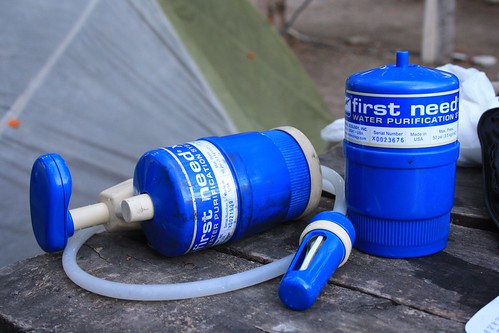
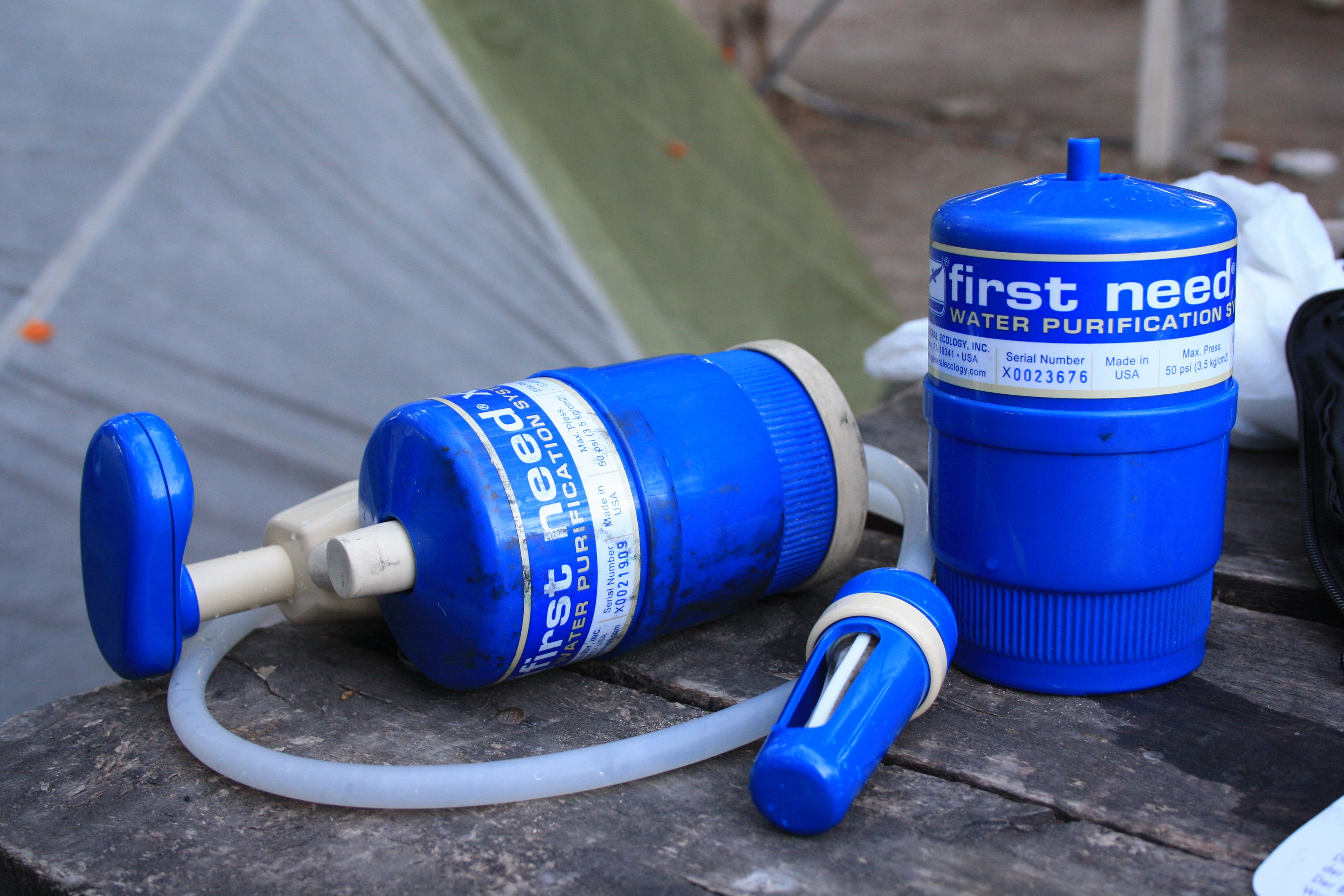
Food Prep
We brought a cellulose sponge for washing dishes, and that was a mistake because they take quite a while to dry. Next time we’ll bring one of those artificial foam sponges because you can squeeze almost every drop of moisture out of them before setting them to dry.
We’re undecided about this. It gets spectacular reviews, whereas most stoves get mediocre reviews, and our first one worked great. But the fuel filter on the replacement we were sent after the recall started getting clogged the first time we used it. We didn’t figure out what the problem was till the end of the trip. The manufacturer was great about helping us out with getting one quickly due to the time crunch between the recall and the start of the trip. We’ll get a new filter and give it a few tries back in the states before committing to it on the next trip.
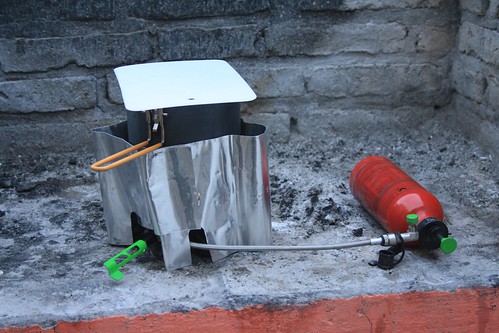
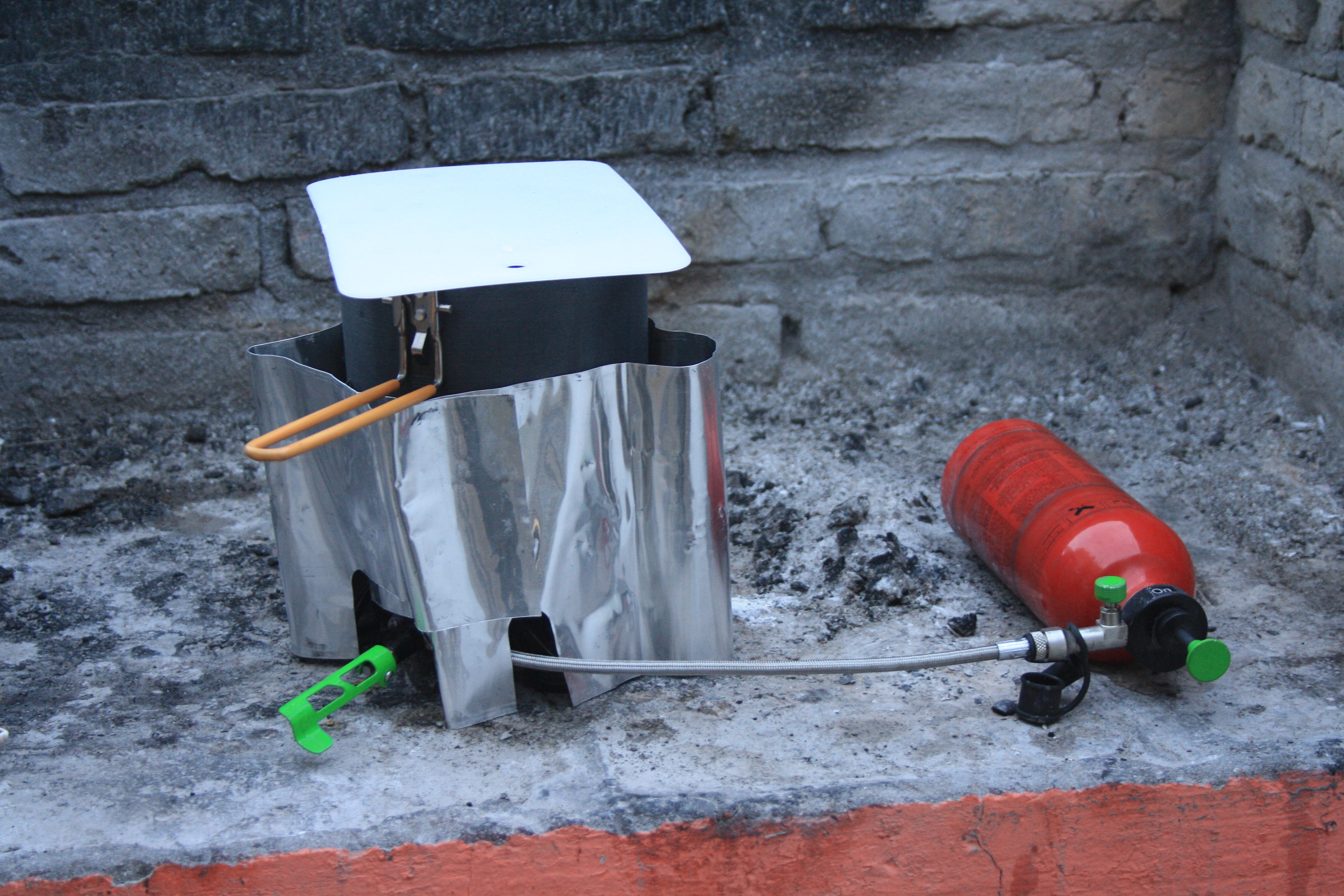
Dachary made the call to bring a Gerbing hunting/camping knife as a separate food-safe knife that was to be used exclusively for food. It made cutting beef, and everything else trivial. Not a requirement, but we liked it and will bring it next time. Kay suggested just using the Leatherman knife until Dachary reminded him of everything else we use the Leatherman knife for. It was a compelling argument for a food-only knife.
We definitely appreciated having somewhere clean to cut meat or veggies. Took up essentially no space, weighed nothing, and we used it as a replacement lid on our pot when we screwed up and melted the one it came with. You can also use it as a serving dish, a plate, etc.
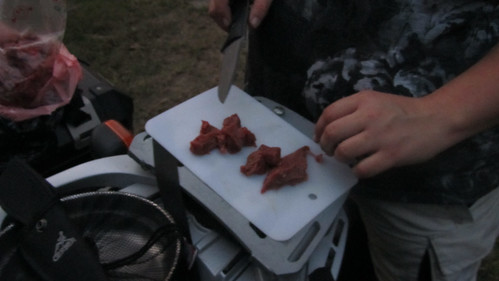
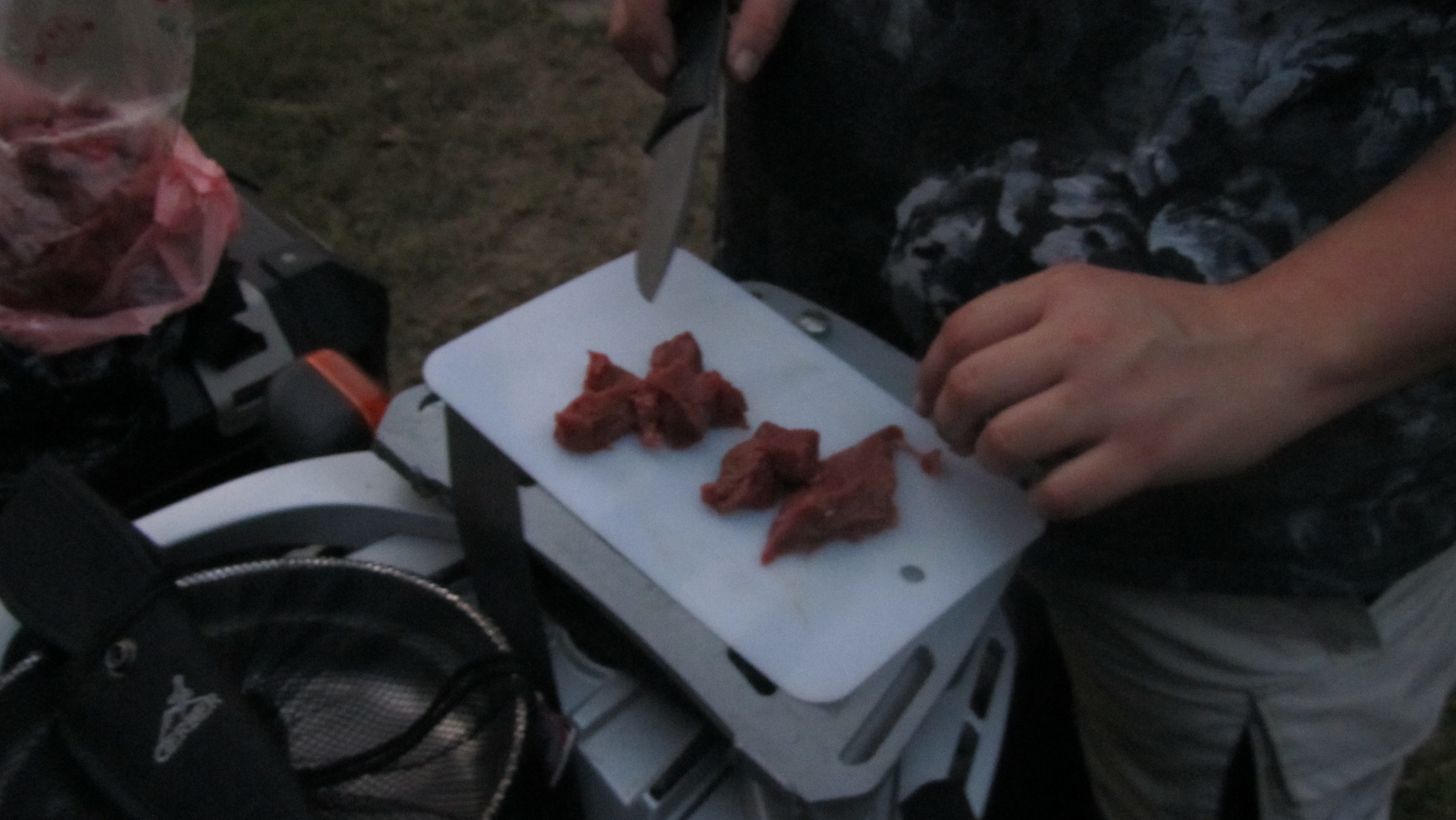
GSI Outdoors Pinnacle Dualist (pot/bowls/cups)
This is an excellent compact solution that gives you a pot, two cups, two bowls (insulated), and something to wash them in. All of it fits within the pot. We love this thing with one exception. The lid is plastic and if you accidentally let the water boil out of whatever you’re cooking it will melt and be useless. We’d happily pay for another set if it came with a metal lid.
Update: We just spoke with GSI. They’re working on upgrading the plastic on the Pinnacle Dualist, BUT they’ve also come out with the GSI Glacier Stainless Dualist which is the same kit except that the pot and lid are made from stainless steel, and only slightly more expensive. Also, when we told them what happened to our lid they offered to send us a replacement lid in stainless steel. Once again buying good stuff rather than cheap stuff has paid off. Thanks for the great customer support GSI.
Celulose sponge
This was a mistake. You’ll want a good scrubby sponge for cleaning your dishes but don’t bring a cellulose one. Instead choose one of the artificial yellow foam ones. You can squeeze almost all the water out of them and they dry pretty quickly. A cellulose sponge is sometimes still damp in the morning.
On the Bike:
In the end we both decided we preferred the BeadRider beaded seat cover over the AirHawk. The AirHawk provides a soft and constant pressure that adjusts as you move. Unfortunately this means there’s an inescapably constant pressure on your butt. A beaded seat cover allows you to move around to relieve pressure points and is surprisingly comfortable. Three of the AirHawk’s four strap attachment points ripped out of the cover, and whenever it rained while you were off the bike you had to sit your nice dry butt on a soaking wet cloth cover. While we didn’t have any problems a few riders we encountered had an exceptional amount of trouble with their AirHawks getting leaks and requiring lots of patching.

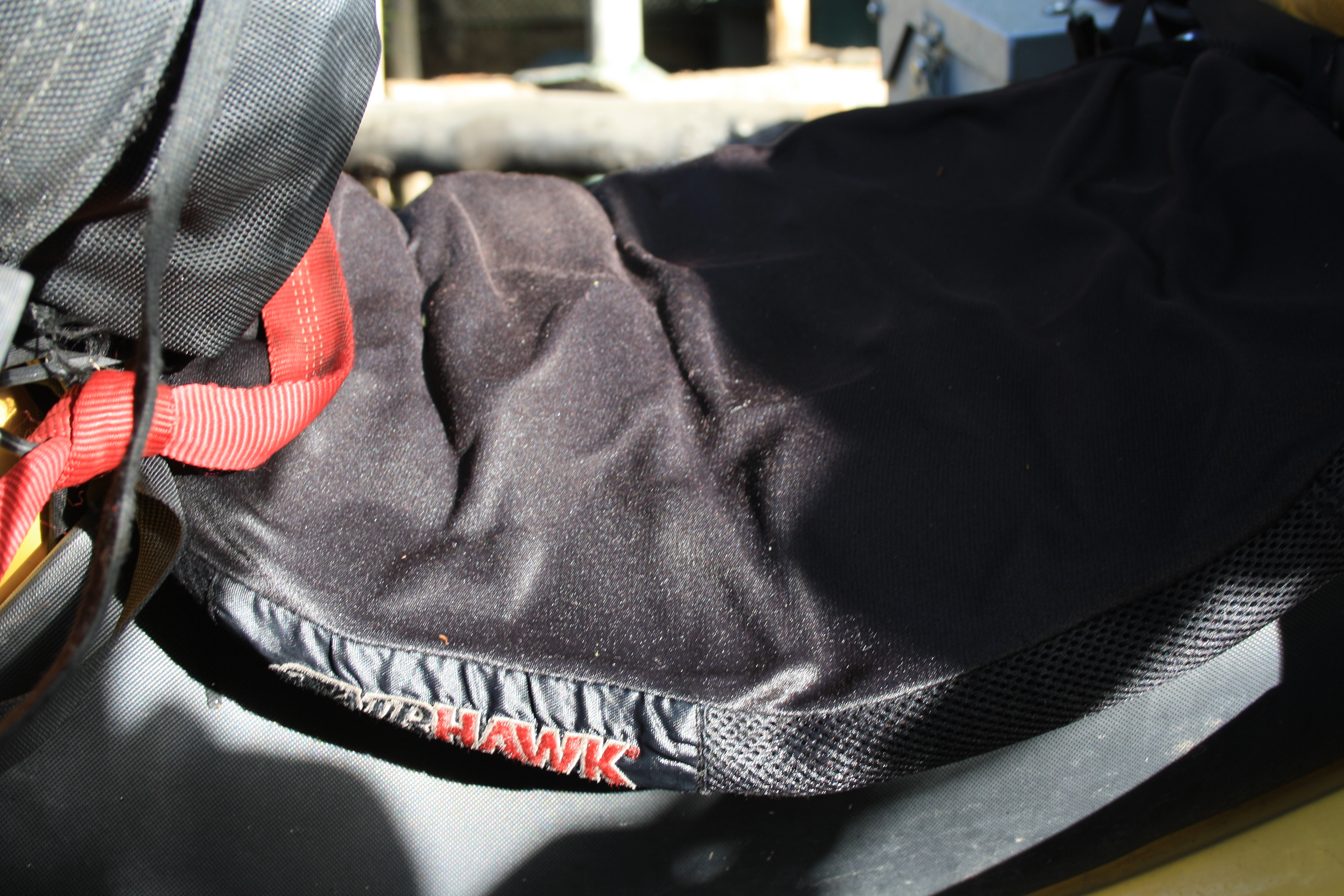
The BeadRider wasn’t perfect though. Too many accidental kicks when throwing a leg over the seat snapped the heavy-duty fishing line that holds the beads together. A few beads were lost on the side, and we had to re-knot them in a few places to keep other beads from falling off. The slipperiness of the ceramic beads left Dachary sliding forwards on her seat. The wooden ones aren’t as durable but they aren’t as slippery under your butt either.
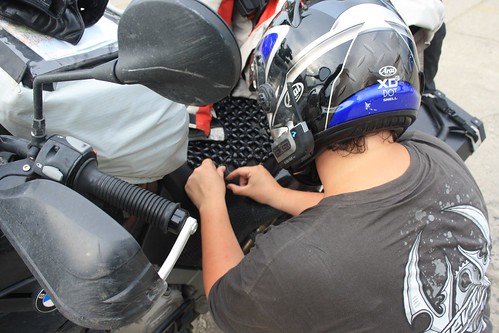
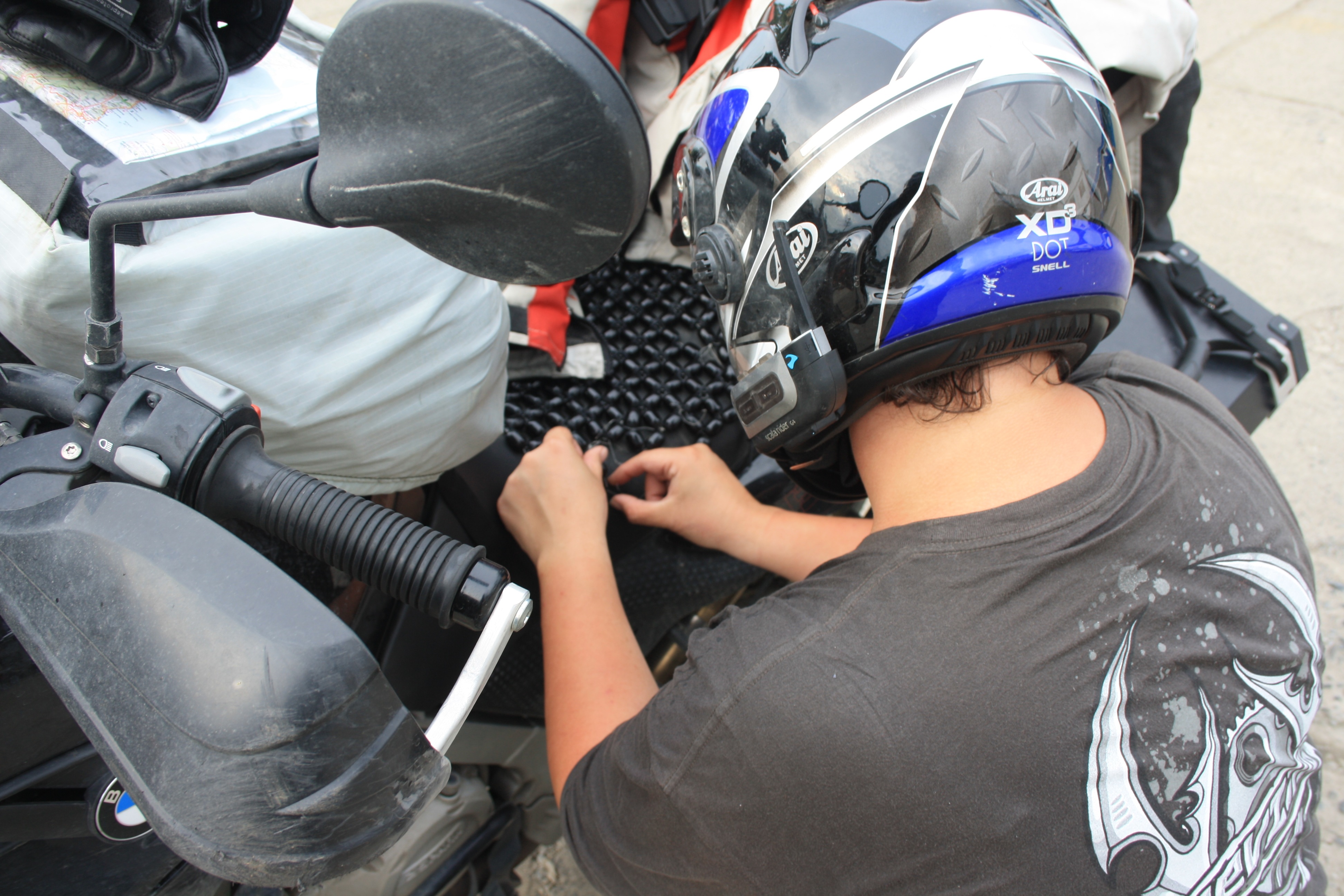
Dachary gave up on hers along the way. She was unhappy with how the zip-tie delivery mechanism required feeding more zip-tie from time to time (by design) and didn’t feel it was a thorough enough coverage. Additionally she disliked not having something to clean the chain with. Next time she’ll bring a brush and a can of chain-lube. We picked up some S10 chain lube along the way and liked the tiny spray tube it had. Kay, on the other hand, was pretty happy with the Loobman. He likes how low-tech it is and how he could reach down and squeeze it when he happened to remember while riding.
Oxford Heaterz Heated Motorcycle Handlebar Grips
Worked great and never needed to turn them all the way up, even in sub-freezing weather. Unfortunately the buttons for adjusting the temperature are nigh-impossible to manipulate when wearing winter gloves and it the unit resets itself to the lowest setting when you turn the bike off.
FuzeBlocks FZ-1 Fuze block
This product is notable because it’s very small, and unlike every other fuze block out there allows each item to easily be switched or unswitched. When the bike turned off so did the electric jacket and grips. No more needing to remember to turn them off or drain the battery. The GPS on the other hand stayed on so that you could ponder the map.
Worked great, and is probably the most affordable lighting system of its kind. When Kay’s headlight died we simply pointed them down more and used them as replacement low beams. When we were driving in near-zero visibility it gave us confidence to know that oncoming trucks would be able to see them through the mist. When we turned them on at night the road was absolutely visible. We highly recommend these. Next time we’ll spend the extra cash to get a second set for Dachary’s bike, too.
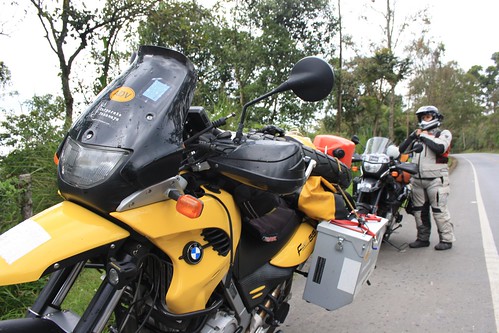
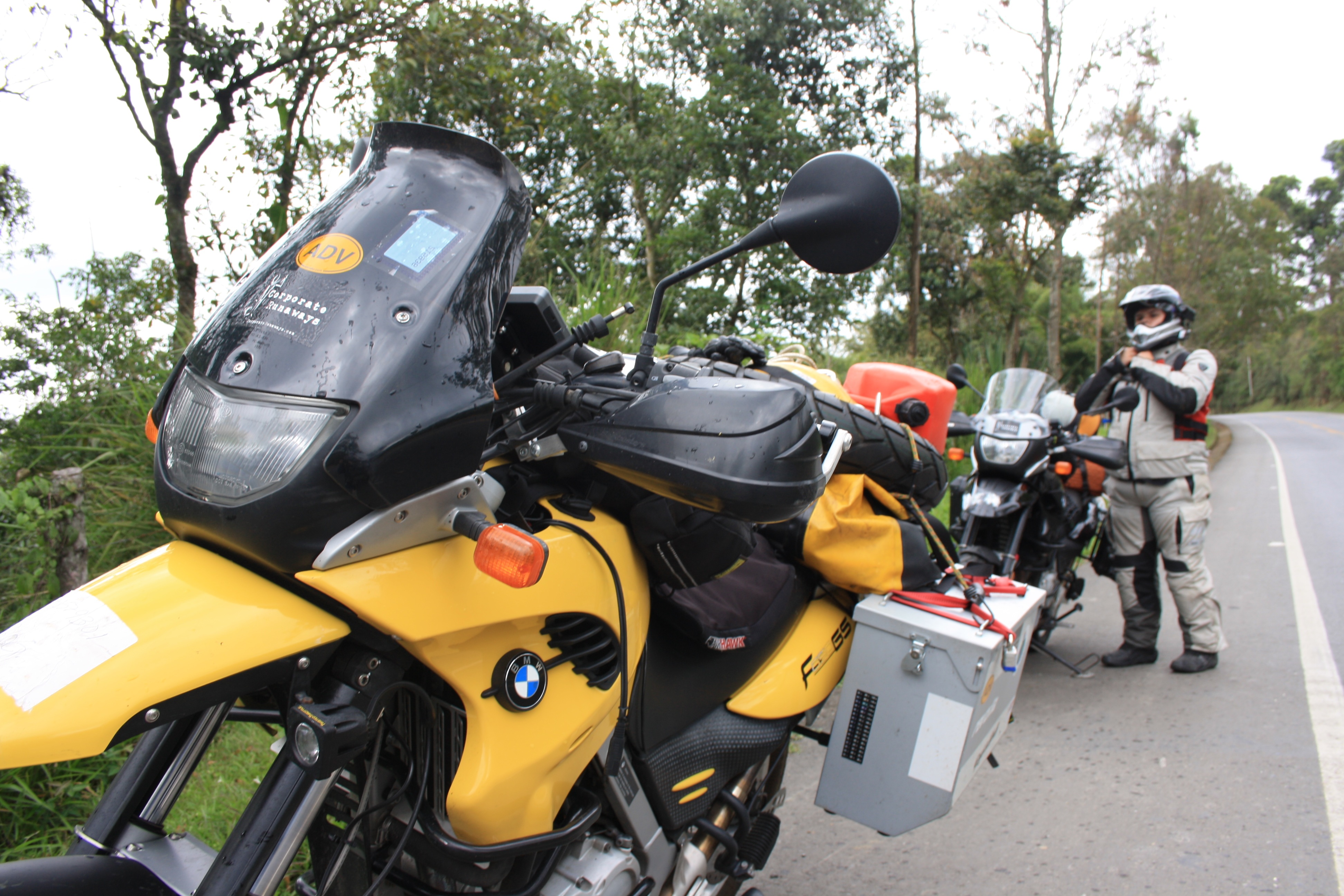
Welded kick-stand foot extensions
One of our favorite mods was the “big fat feet” we had an Ecuadoran welder attach to our kick-stands after the Touratech ones had fallen off.
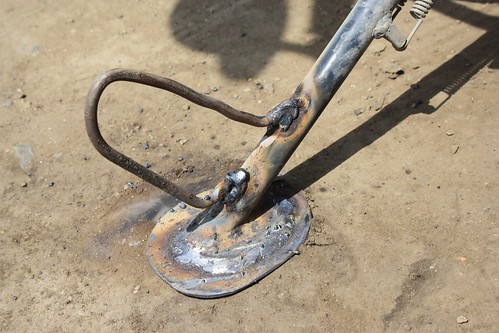
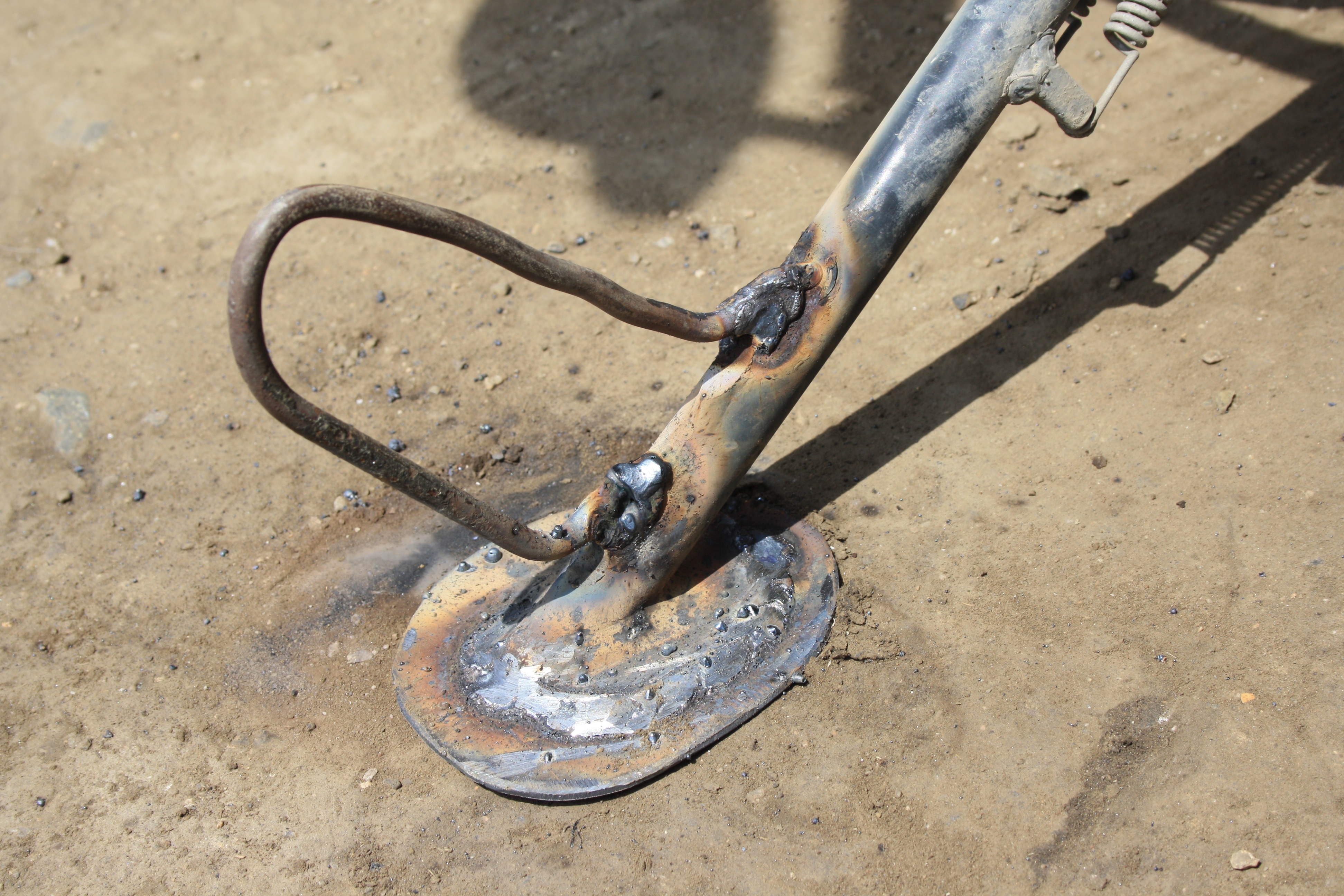
DID X-RING Gold Chains
The general consensus is that you simply can’t buy better. Ours have over 18,000 miles (29,000 kilometers) on them and have shown no sign of stretching. They should probably be replaced at this point but neither of us was fearing them at the end. They’d probably be in better shape if we had chain lube and cleaning brushes and were maintaining them thoroughly throughout the trip.
Panniers
There are few areas more opinionated than pannier selection, and we’ve formed a couple general thoughts about them. Easy on Easy off is a bigger deal than you think. Every time we went into a hotel Dachary would walk behind her bike and have her panniers off in roughly ten seconds. Kay would be unlocking, unlatching, and unscrewing the pucks in his for the next couple minutes. We decided the extra time of unscrewing pucks wouldn’t be nearly as bad if one of us didn’t have something so ridiculously easy to remove as Dachary’s.
We’re not fans of the puck systems that so many metal pannier manufacturer’s use. It’s annoying to have to open the pannier and dig down into it, sometimes needing to remove things, to get to the pucks and then unscrew them just to get your pannier off or on. One requirement for the next panniers we be will be that the mechanism that attaches them to the frame is both external and quick to undo.
We bought a full sheet of 3mm Neoprene with a cloth backing from FoamOrder.com and carefully mapped out the shapes of every panel we’d have to cut from it. Then used some 3M spray adhesive we picked up at an art supplies store to attach it. A half sheet of neoprene should be enough for one set of panniers. This proved to be a really good idea. No rattling, no black stuff from things rubbing against aluminum, and it provided a little bit of shock absorption for the contents of the pannier.
Kay went with the Happy-Trail 38L Teton Panniers. We felt they were very well made, and don’t think you’ll find anything significantly more sturdy, especially not for the price. The frame was also very good. We were disappointed when Kay’s was ripped off because the bolts in the pucks that hold it on did not shear. Instead the frame got tweaked and the little L shaped pieces of metal the the pucks screw into and hold the panniers onto the frame ended up bending the pannier until the angle of the L was such that its hold was less than the force being exerted by the ground. We honestly believe that Happy-Trail needs to switch to shittier bolts. If the bolt had of sheared it would have been a simple matter to grab a Leatherman, grab the end, unscrew it, and replace it. Instead, we’ve got a bent frame and L pieces that barely hold because, even after repeated banging with rocks, bricks, and axes, they are still not at the right angle. You can’t get anything inside the pannier to help flatten it from the inside. Maybe a tiny bottle jack would work… There are a number of people out there who are soft-bag fans because of the possibility of getting your foot trapped / crushed between a hard pannier and the ground. This happened to Kay twice and if it wasn’t for the malleolus armor in Kay’s boots we’re convinced the ankle would have been broken. With the armor it was just the lingering pain from a bruised bone.
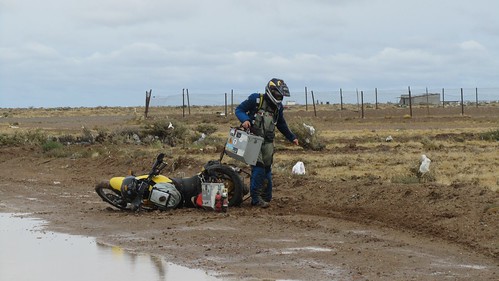
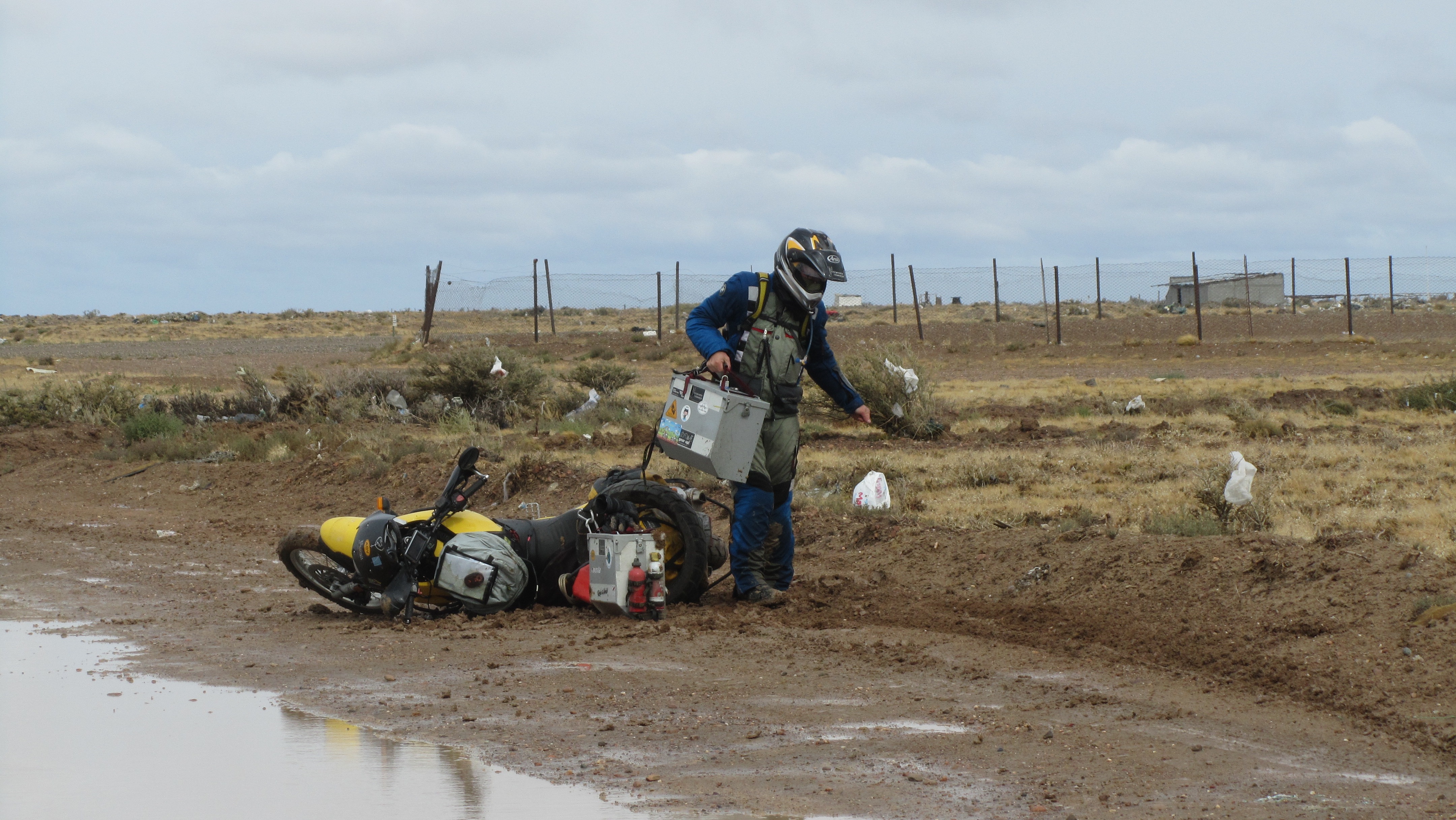
The Happy-Trails panniers were modified with Carry handles, Touratech 2 Bottle holder (MSR Bottle and Fire Extinguisher), and Touratech 2 liter Canister holder (emergency emergency fuel).
Dachary went with the SW-Motech Trax cases which we made the same handle-mod on. As noted above, we loved the ease of use of these, but in almost every other aspect they failed. The lid of each pannier has space in it, but unlike Jesse Cases there’s no way to actually hold anything in the roof. We ended up using wire hangers bent in just such a way which kinda-sorta worked for large items like shoes. The Quick-locks that hold the SW-Motech frame together both self destructed as a result of tiny, no-speed drops where the slightest pressure (the weight of the bike) sheered the pins off the locking mechanisms. Dachary is convinced that in an off capable of ripping a pannier from a bike the frame would self-destruct, which would leave you totally screwed. How do you attach the pannier to a frame that’s not really there anymore and limp to the next welder? Kay’s convinced that the thin piece of bent aluminum rod that you use to latch the panniers to the frame would be ripped off and then you’d be screwed because it’s not just something you can weld. It has to be just the right size and bent at just the right angles.
The corners of the Trax cases are plastic and, as far as we can tell, nothing is welded on them. Everything is riveted. The plastic corners will easily rip free of their rivets in an off. We eventually ended up finding someone to replace the corner that’d ripped off.
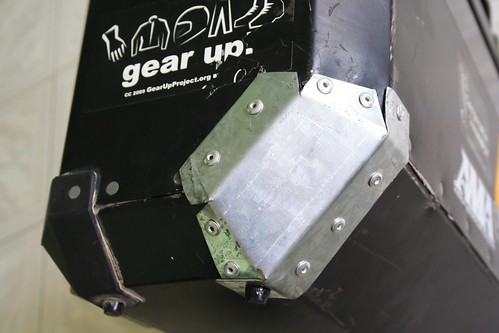
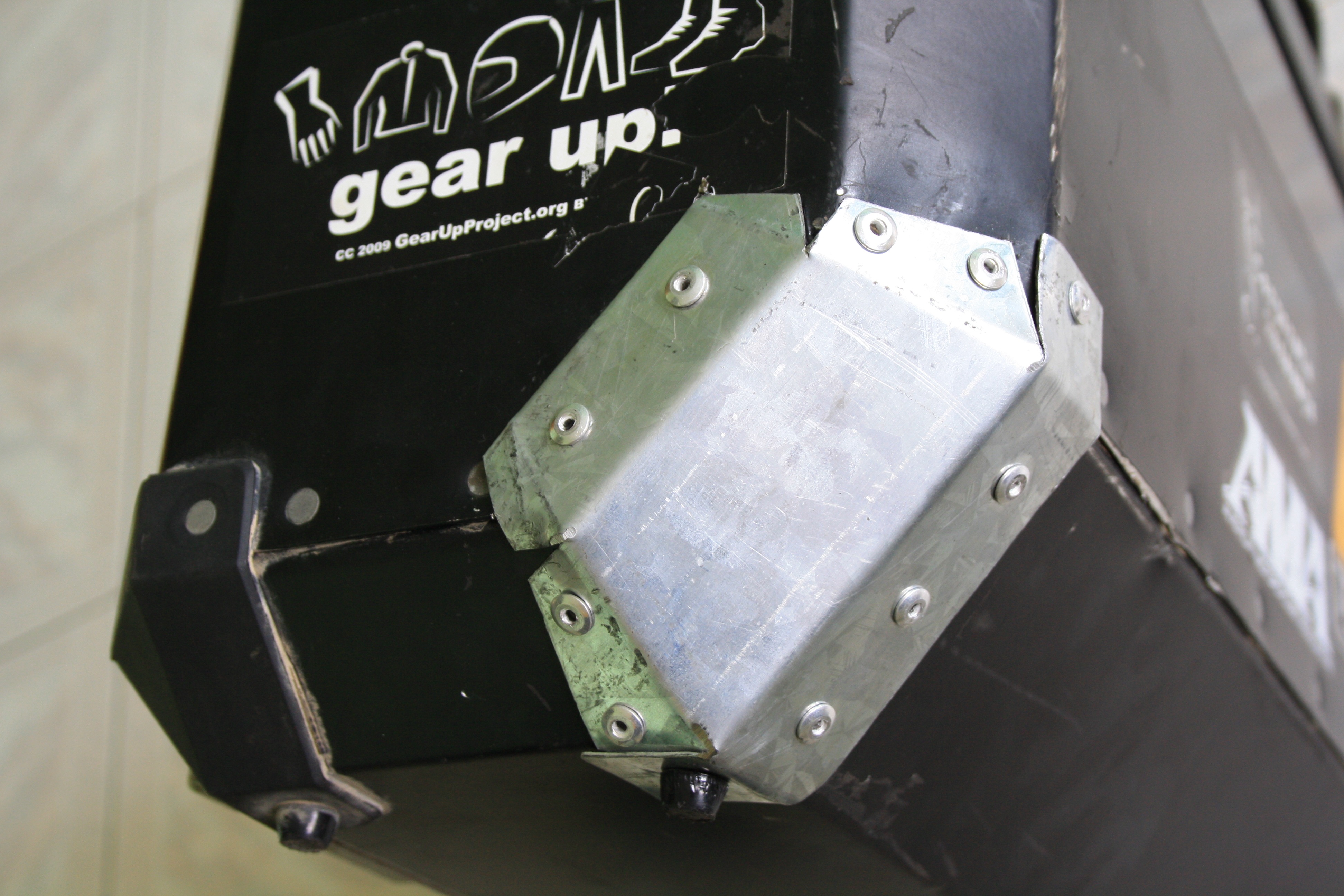
While the cases were initially waterproof (although SW-Motech no longer markets them as such), they began to quickly get things wet inside after a couple of drops. The riveted panels pulled away slightly and made enough of a gap for water to leak inside - particularly the right pannier. We do not believe that this would happen with the Happy-Trail panniers unless there was a very serious dent. Everything in our panniers that wasn’t supposed to get wet was in one of our many dry-sacks. This proved wise with the Trax cases.
On the Hard vs. Soft debate we’re still somewhat torn. We both went with hard for the peace of mind they provide. On one of the test rides with Kay’s soft luggage he was constantly concerned about someone getting in to it. On the journey we had no problems with people trying to get into our cases, but we also didn’t worry about it either. We’re not sure it’s needed, and if we were doing a trip just within the USA we might go with soft luggage, but we definitely appreciate the security aspect of hard luggage.
On the Humans:
BMW Rallye Pro 2 suit
Great construction, exceptional armor, surprisingly good ventilation. Can’t recommend it highly enough. We’ve looked at the Rallye Pro 3 and believe that they’ve taken the excellence of the Rallye Pro 2 and made well chosen enhancements. Ignore the fact that people think you bought it because of the BMW roundel and buy it because it’s excellent.
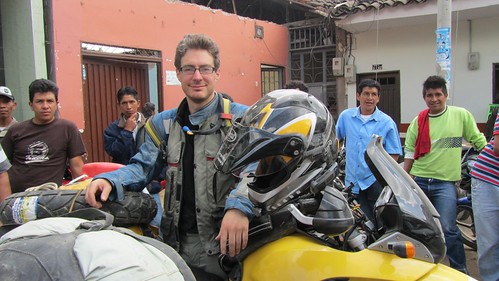
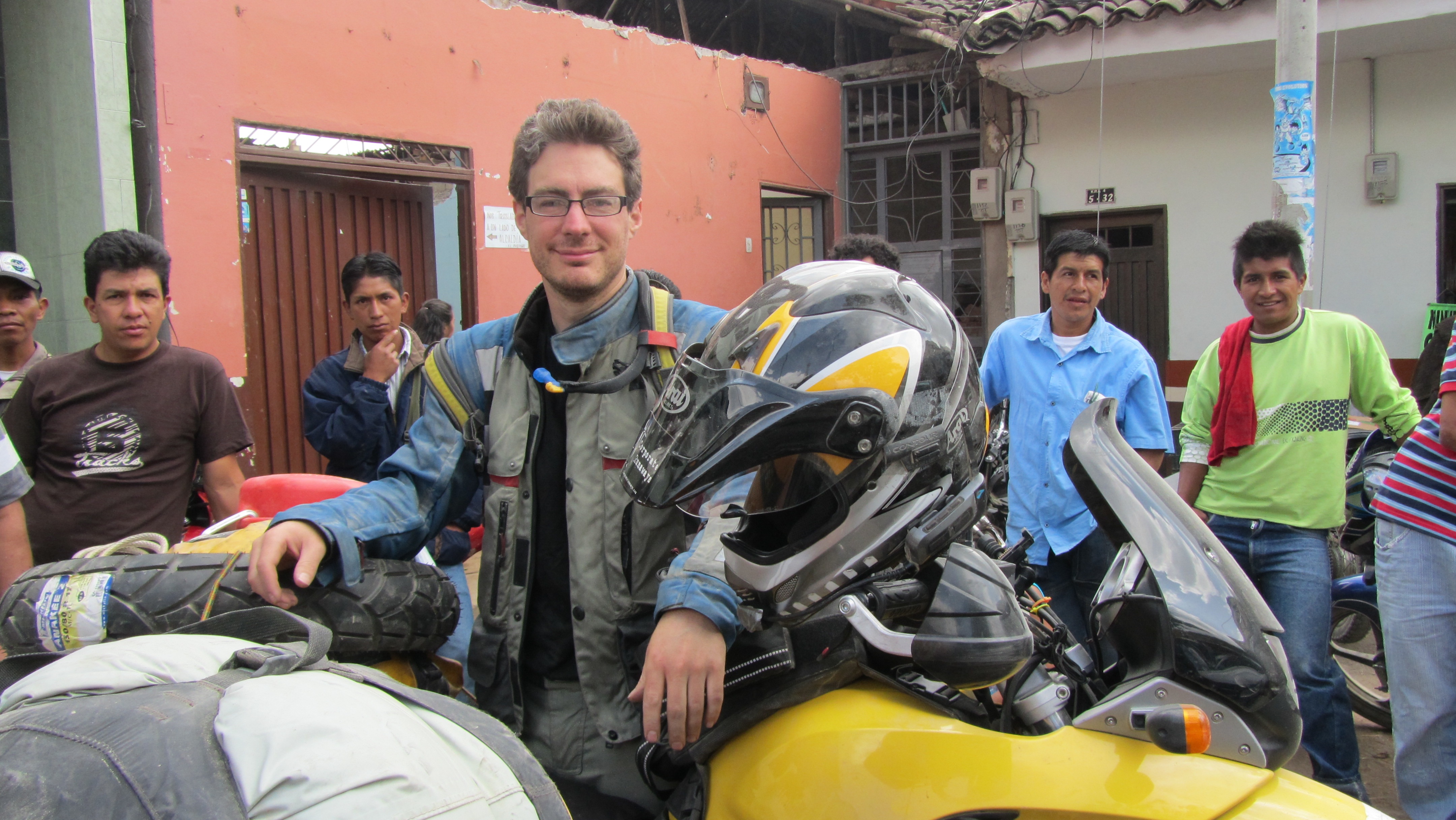
The waterproofing was excellent. Without the malleolus protector Kay’s convinced he’d have broken his left ankle, possibly twice. Only downside is that the edging at the top is very itchy for at least a month of riding, and after that it’s mildly itchy. Tall socks are required. After using them long enough Kay decided that the boots had become so comfortable that it wasn’t worth the effort of digging out normal shoes if he wasn’t going to walking particularly far (more than a couple miles).
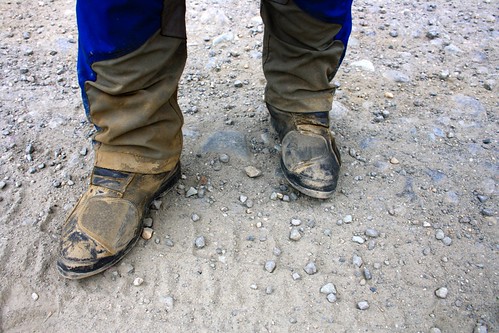

RevIt Rival H20 Boots
These had a zipper that was way too fine, got borked on the first encounter with dirt/mud, and ripped off when trying to extricate a foot from them. These boots might be good for highway touring and commuters, but they’re simply not practical from a construction standpoint for adventure riding. Any off-road at all is virtually guaranteed to cause problems with the fine-tooth zipper. Otherwise, they were comfortable and perfectly fine for certain applications, especially in their price point - just not for adventure riding.

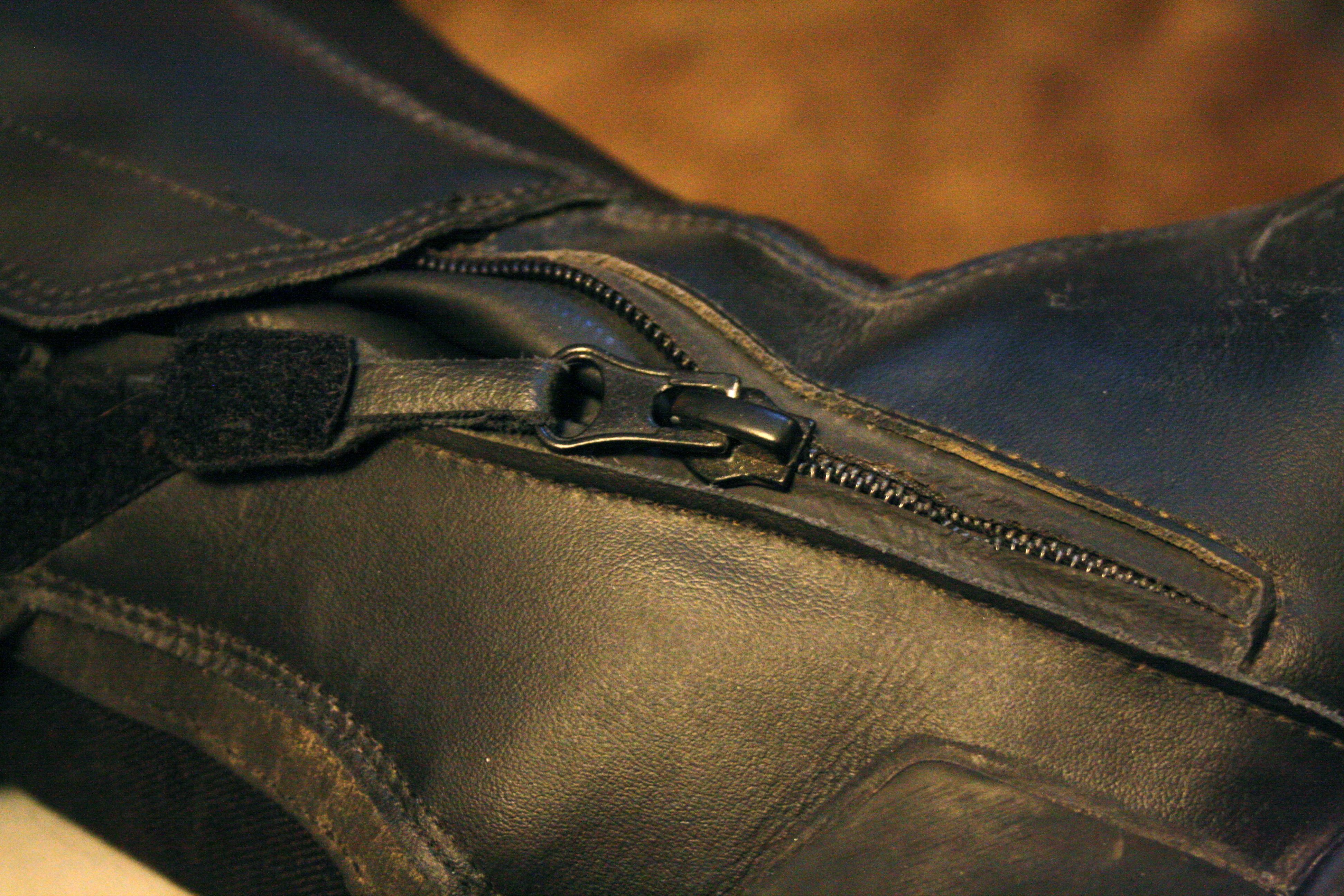
We ended up returning them at the beginning of the trip and replacing them with…
These lost all semblance of waterproofness by Colombia at around 6,700 miles and around 50 solid 8-10 hour days in a row of riding, but were otherwise well loved by Dachary and greatly preferred to the Revit Rival H20 Boots due to their thicker soles and extra shin protection. The extra height they provided was just enough to make it easier for Dachary to maneuver her bike in in parking, which she had to do on tippy-toes until the bike got shorter. We’ve been told that Gore-Tex will guarantee the waterproofing in any product that uses it but haven’t contacted anybody yet about the waterproofing of these boots.
Gloves
Dachary went with the RevIt Monster Gloves for the warm weather. For safety reasons we don’t recommend short gloves for most riders but Dachary’s sleeves were actually a bit too long and, she believed, would cover, and protect, her wrists from scrapes even when pushed back up the arm. The Monster gloves wore great, and were extremely comfortable when broken in. They don’t feel particularly protective and certainly wouldn’t have done much in a bad off, particularly in off-road conditions, but they were great for long-distance touring with mostly paved riding.
Dachary had the RevIt Zenith H20 Gloves for the rain and cooler temps. Kay seriously regretted not getting these too. While it may have been excessive to carry three pairs of gloves, there were times when it was too cold for the Monster mesh gloves but not cold enough to justify the Held Warm N’Dry gloves. The RevIt Zenith gloves were the perfect compromise for those in-between temperatures. Also good in the rain.
Kay went with the Joe Rocket Sonic Gloves for the warm weather, but discovered that his thumb (average sized) got slightly jammed when twisting the throttle and eventually had to take out the stitching in the top of the thumb so that it could poke out. Dachary had these before the trip but the felt in the palm wore through near the thumb and became uncomfortable bumps at the edges of the wear holes. They’re definitely good from a safety perspective (Kay’s wearing the ones that saved Dachary’s knuckles in a lowside) and were comfortable for Kay other than the thumb issue, but neither of us would buy them again.
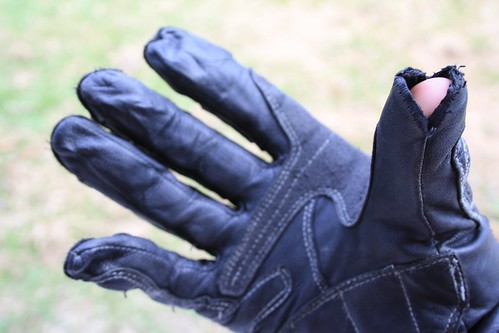
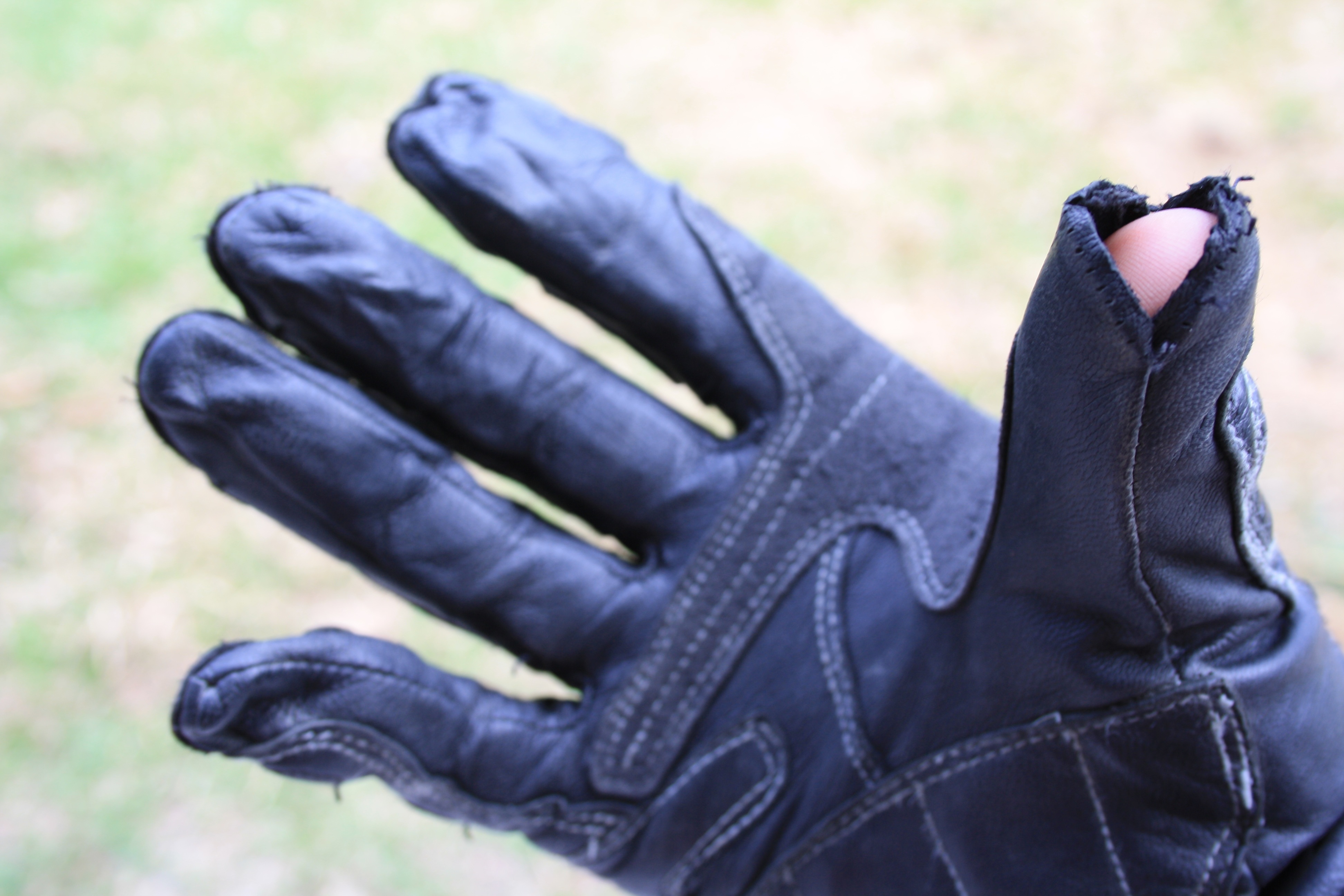
Kay went with the Aerostitch Triple Digit Rain Covers instead of the RevIt Zenith H20 Gloves, despite a total failure on a test run where they turned into water balloons surrounding his hands. This had been chalked up to user-error. Not buying a second pair of rain gloves would save us money and he didn’t mind the slipperiness of them. On the trip it was decided that they were obnoxious and not worth the effort. From then on Kay just let his hands get wet unless it was particularly cold out at which point we’d break out the…
See the note about these in the Outstanding Items section. Short version: buy them. Buy them now. Just remember that they’re designed to be used with heated grips.
Electric Jackets
Dachary went with the Gerbing and Kay with the Aerostich Kanetsu TLTec Windblocker. Our initial review made the Gerbing out to be the clear winner, but after 18,000 miles it’s not so black and white. Yes, the Gerbing heated up faster and kept your arms warm too, but the first Gerbing jacket died on us, and the second one had a tendency to shock Dachary at regular intervals unless she wore thick insulating layers beneath it. It was quite painful when turned up too. And, when the first Gerbing died it provided essentially no warmth.
The Aerostich on the other hand burned Kay when worn with the thin side against the skin and turned all the way up, but reversing it to put the fleece between the wires and the skin solved that problem. While the arms weren’t heated like the Gerbing it did a good enough job at keeping Kay’s core warm that it wasn’t a big deal. And, most importantly it still provided a measure of warmth due to its fleece side even when it wasn’t turned on. The Aerostich’s lack of pockets was particularly annoying when walking around in it, as was it’s “motorcycle” cut meant it came barely to the waist when riding and rode up to high when walking around.
So, the question is, would we recommend either of them? We’re not sure. Gerbing has a great reputation and is definitely willing to replace faulty products, but we’re concerned that both jackets had problems. Also, willingness to replace a faulty product doesn’t help when you’re in another country or on another continent and don’t have a shipping address. The Aerostitch has 1970’s technology, but as a result it’s not nearly as finicky, and we love that it has a fleece side that’ll keep you warm should it break, or if you’re just walking around town. The cut and the lack of pockets though…
We highly recommend getting an electric jacket, we’re just not sure which one you should get. Kay’s considering the exo2 gear for the next trip.
Personal Hygiene:
Baby Wipes
Far too many uses to list. About the only thing you can’t clean with them is your visor because they leave a thin film of residue.
Travel toothbrushes
The kind that fold, or split into two pieces. Normal toothbrushes are too long for a toiletries stuff sack and chopping off the end of the handle leaves it too short for comfortable use. Plus if you have the kind that you split into two pieces and it goes inside itself like a little case, it keeps your toothbrush from getting stuff on it from your other toiletries (i.e. leaky soap, etc.)
Towels
We each brought a “large” chamois style MSR PackTowl which was more than sufficient to get us dry and packs very small, but next time we’ll bring the extra large one. The difference in packing space is negligible and you should be able to wrap an XL one around you when you step out of the shower in a campground. You can’t wrap the smaller ones around you.
We also brought a tiny version for drying the dishes. We weren’t sure if bringing a chamois towel for dishes was a good call or not before the trip, but in the end we think it was great.
Mimikaki
You could bring a bag of Q-tips, but that takes up space and needs to be kept dry. A mimikaki on the other hand can get wet, is reusable, and takes up less space than a pen. For those who don’t know a Mimikaki is essentially an ear spoon. Americans tend to put this in the “gross” category but really it’s no worse than a Q-tip and the Japanese have been fans of them for years. Kay went with a poor man’s Mimikaki made from a paperclip (not as dangerous as it sounds), but you can buy real ones from sites like J-List. We recommend getting a metal one if you can find it. Side note: Dachary does not and will not use this. But also doesn’t have the problems with ear wax that most people have. So to each his own in this regard.
Other:
First Aid Kit
We took the Adventure Medical Kits Mountain Weekender First-Aid Kit and beefed it up with a number of additional items (see our Office Supplies page for details). We also brought their Suture / Syringe kit, because we’ve been advised that there are a number of hospitals in the world who can’t afford fresh needles and need to reuse them. We suspect that this probably isn’t the case in the Americas, but just in case…
We chose, and would recommend, the Adventure Medical Kits Mountain Weekender First-Aid Kit because of its very easy to read section labels. We know from experience that in stressful situations you don’t have the mental capacity to hunt for things. If someone’s bleeding you want a pocket that says “Bleeding”. All of the first aid kits we’ve seen that have any hope of fitting in a pannier need to have items added to them, but we think the clear labeling is a definite benefit in stressful situations. Also the first aid book that it comes with is quite good; not one of those crappy booklets most kits come with. We’re not sure we’d bring the suture kit to the Americas again, but if you’re heading to Africa or Around the World we’d definitely recommend it. We’re happy to report that we only used the kit for burn gel and some pills, although we did consult the book several times to diagnose Dachary’s diarrhea, degree of sunburn, altitude sickness, etc. On a related note, if you’re fortunate enough to have an old-school pharmacist nearby, explain what you’re about to do and ask them if you could have any of their first aid related items or pills that are either about to expire or just expired recently. Ours offered us a number of useful things that he was just going to have to throw out.
Ziplock baggies
Lots of people recommend these. We recommend against them. Every single ziplock we brought ended up self-destructing, and not just a little tear self destruction either. They completely wore out. Holes everywhere. Even nice round things like batteries couldn’t be kept. Save yourself the frustration and just get some small, lightweight dry sacks for holding things in your panniers. We got a few multi-packs of small dry sacks from Amazon.com and they were great as both stuff sacks and at keeping important things dry when our panniers did get wet.
Money Belts
Neither of us ever wore them. Dachary put extra cash and cards in hers but left it somewhere not on her person. it may as well have just been an envelope. Kay never put anything in his. We wouldn’t bother next time. We went with the advice of carrying a wallet that has fake cards and just enough cash for the day. If it gets stolen, no biggie. However, we had no problems in this regard on the entire trip.
Maps
The advice we’d received was to get maps with a scale of at least 1:500,000. In some cases we were able to find maps with a scale of 1:250,000. Some maps had great road coverage but no topographical information. Some had good roads and topographical information. Some were waterproof, some weren’t. Our advice is this: If you’re the type who goes out of their way to frequently ride tiny dirt roads then get a 1:250,000 scale map whenever you can. If that doesn’t sound like you get 1:500,000. The problem with the 1:250,000 scale is that when you’re traveling at normal pavement speeds you have to refold them three times a day just to keep the part you’re riding on visible. Always get a map with good topographical information. The map we had of Chile was very easy to read, but we had no clue when we were about to deal with mountains and valleys which seriously impacts your riding speed due to all the squiggles. Also, it’s good to know when you’re about to climb into the mountains because it generally gets quite chilly when you do.
Waterproof maps, when you can find them, have a surprising side-benefit. They’re much more resilient when it comes to all the abuse your maps take from being constantly refolded to fit into the map pouch on your tank bag. Most of our paper maps look thoroughly beaten, and some have holes at some of the fold corners.
We need to make special mention of the National Geographic Adventure maps. If you want a detailed map (1:250,000) these are easy to read, waterproof, contain topographical information, and include “dirt tracks” and “trails”. The only downside is that they’re only available for a handful of countries.
Salted / Roasted Almonds
The salted ones are hard to find on the road, but you’ll sporadically find fresh ones. We recommend these, because they were always greatly appreciated when we nommed on them from a tank bag, and they take a while to digest so your body receives benefit from them for quite a while afterwards. If it’s mealtime and you can’t find anything nearby, grab a couple handfuls of salted almonds.
Oxford Spanish / English Dictionary
Something like 70% of the words we tried to look up (Spanish and English) weren’t in there, but we found an unexpected benefit. When we were trying to convey something important, but lacked the vocabulary, we’d pull it out and look up the world. Frequently the other person would get interested and, once you’d figured out your word, borrow it to look up something they were trying to convey to you. So, while we wouldn’t particularly recommend *this* dictionary, we would recommend bringing a paper dictionary, in addition to having a copy of Ultralingua on your iPhone (see below).
Fire Extinguisher
Didn’t need to use it, but glad we had it. Also, it turns out that there’s a common scam amongst corrupt cops in South America where they claim you are required to have one even though you aren’t and try and get a bribe out of you. Ditto for warning triangles, which we didn’t have.
Business Cards
You’re going to meet people who are interested in your trip. You can either tell them your URL and hope they remember it, or hope that someone’s got a piece of paper and a pen. Or, you can simply carry business cards. It should be noted that standard US business cards will just fit in a large Altoids tin. The corners might get compressed slightly but not badly, and it’ll help protect them from getting beaten up. We carried a couple tins of them and were very grateful to have them to hand out.
Cameras
We were planning on both getting new point-and-shoot’s for the trip, and after doing a lot of research using Flickr’s Camera Finder to see what real world pictures looked like from various cameras we decided on the Canon PowerShot SX210 SI. Dachary bought hers, but Kay decided to spend his money on a used DSLR and found a Canon EOS 1000D / Rebel XS on eBay for about the same price $350. We also had an old Canon PowerShot SD1000 which was the “riding camera”.
The old PowerShot got tethered to Kay’s tank bag and was used for shooting while riding. If something horrible happened as a result of it being used on a motorcycle we weren’t going to be too bummed. The tether definitely came in handy as it was dropped or slipped out of where it got shoved for easy access while riding a number of times. Sadly Kay managed to forget it was there, pull the tank bag off the bike and cause it to hit the ground when the tank bag was lowered… repeatedly. Now, the shutter doesn’t always open up completely.
The combination of a good point and shoot (the SX210) and a DSLR is one we’d highly recommend. Mostly we just put the DSLR in landscape mode (no flash) and let it do everything automatically. A telephoto lens would have been nice, but the one it came with was surprisingly good. The 14x optical zoom on the SX210 compensated when the DSLR lens couldn’t capture something small or far off, but time and again we were impressed with how much better the color quality is on the DSLR. Megapixels aren’t everything.
Our advice is to bring a good point and shoot you can throw in your pocket while walking around populated areas and a good DSLR for the really important / beautiful shots. And, if you have an old one, or can afford another, a point and shoot for your tank bag that you don’t mind risking the life of.
Video Cameras
We brought a Contour HD, a Contour GPS, and a V.O.I. P.O.V video camera. The Contour HD worked flawlessly and provided great video. The Contour GPS worked flawlessly and provided great video until the USB port on it that you use to charge it and get data off broke and pushed into the camera where you could no longer access it. The P.O.V. never got used even as a replacement for the broken Contour GPS because the remote never seemed to reliably start a recording so you have to keep the screen on the main body visible and there’s a big-ass fiber optic cable running from the body to the lens on your head. So, every time you step off the bike you have to remove the camera from your helmet and stow it away. (However, another rider told us that the GPS seems to interfere with the signal from the remote, and if you move the remote further from the GPS unit, it might work reliably. We never got around to testing this.).
Also, because you want to not go through batteries at an insane rate you have to wire it to your battery (there’s an adapter for that) but the device must be powered to get video off of it. So, you either have to hold your laptop next to your bike while you download the video or you have to stick in some batteries (it won’t power itself from the USB connection) and then remove them when you’re ready to plug it back into the bike. All-in-all the added complications and frustrations that the P.O.V presented didn’t make Kay feel like bothering. We pondered Velcroing it to the bike, but didn’t want to deal with having to detach it from the bike every time we walked away from it. We recommend a nice cordless helmet cam like the Contour HD or GPS. Just be sure to keep it charged so you don’t miss that incredible moment.
The GPS functionality on the Contour GPS is, right now, largely a gimmick. You can only share it via their video site, but we chose it because even though we planned to share the video on other sites, we’d be able to use the software on our laptops to know exactly where the video was taken which we found a useful thing on a trip like this. No more wondering “Where was this?”
When we met up with OsoBlanco (on ADVRider) on the road and told him of our dead camera he mentioned that on his Around the World trip he and his companions managed to kill five Contour HDs. He’d also had trouble with the remote on the P.O.V. whenever it was too near his GPS. For this trip he’d switched to the Drift HD170 which seemed to be working ok for him, although we all agreed that no-one in the motorcycle camera space has gotten it *quite* right yet.
It should be noted that right now the V.O.I. P.O.V is the only helmet cam we could find with a microphone in. So, if you want to narrate while riding (wind noise will be hard to overcome) it’s your only choice.
Computing
We brought two mac laptops and an iPad. Two laptops is a bit excessive for most, but Dachary still needed to work for some of her clients from time to time and we were determined to keep up the daily posts. Writing daily ride reports takes a lot of work, and if you skip writing one evening you have to make it up the next so there were many nights when Dachary was writing one post or working for a client while Kay was writing a post. This was only an option because we had two laptops, and from a space standpoint, it was only justifiable because we had two panniers each. For riding two-up where space is much more of a concern, we never would have been able to justify two laptops.
We brought the iPad because it has an incredible battery life and because with the addition of the thin Apple bluetooth keyboard it becomes a very effective writing device. We believed that we were going to be camping a lot and thought we’d be able to use it for writing the posts. This didn’t happen but we ended up loving it for two other reasons: 1) excellent viewing angle for watching downloaded movies and tv shows. You don’t have to crowd together to have the screen be at the right angle for both. 2) Kay would use the Kindle app on it it to read books downloaded from Amazon, but it’s not nearly as nice for reading on as a real Kindle.
We don’t recommend the iPad for content creation unless you’re using service like Posterous.com to post to your blog. About the only content the iPad is decent at creating is emails and Posterous.com ingests email and converts it into blog posts (on its site and others if you want), uploads the embedded photos and videos to Flickr, embeds galleries and audio players as needed. But, it can’t post to ride reports on sites like ADVRider.
If, however, you’re just posting occasionally, or not at all… Can’t recommend the iPad highly enough. The only downside is that you’re going to have a harder time connecting to weak WiFi signals, which you’ll encounter frequently, with an iPad (or iPhone) than you will with a laptop. The antenna’s just not as good.
Ultralingua
If you have an iPhone grab a copy of Ultralingua. This is an excellent foreign language dictionary (to and from) with a huge vocabulary. Definitely worth the money. Plus many words that weren’t in our paper dictionaries were in Ultralingua. Truly helpful and awesome. (Thanks Eric for recommending it!)
Because they Rock:
On our trip, Revzilla went out of their way to help us with returns and getting replacement items when we were in far off lands. Their support in finding the right items for the trip was exceptional. Their web site is also the best in the industry. For these reasons, because we are incredibly grateful for their support, and because they simply get what it is to be an adventure rider we’d like to suggest making your next gear purchases with them. You won’t regret it.
